Why do planets go retrograde? The physics, the meaning of retrogrades in astrological chart and why the number of them in Natal Chart is important? Statistical research through centuries, unusual case studies of extraordinary people with many retrogrades and lots of graphics. This article contains the basic outline of almost all facets of my study regarding this interesting topic.
★ ☿ ★ ♀ ★ ♂ ★ ♃ ★ ♄ ★ ♅ ♆ ♇ ★ ℞ ★
Edit 2020-06
New material: WATCH A BRAND NEW VIDEO.
I’ve given an INTERVIEW on retrograde planets for an English astrologer, Mary English.
For the description and the list of timestamps go to the YouTube version or a separate article here on my website.
==END of 2020 edit.
★ ☿ ★ ♀ ★ ♂ ★ ♃ ★ ♄ ★ ♅ ♆ ♇ ★ ℞ ★
This is the outline of materials from my lecture on ‘Retrograde Planets and the Number of Retrograde Planets Found in the Natal Chart’, which is an expanded version of my article, “People with many Retrogrades,” that won the contest sponsored by The Astrological Society of Great Britain, and then subsequently published in their March 2014 issue of The Astrological Journal.
This lecture was presented to the Polish Astrological Society (PTA) in Warsaw, and despite inconvenient timing, about 35 people attended, which was a surprisingly large attendance for a single astrological lecture in Poland. I made only Polish version of highly condensed materials in 2-hour long graphic video presentation.
Before I manage to do the English version, you might take a sneak-peak at the content of the Polish video.
>> VIDEO IN POLISH LANGUAGE (2014) <<
Below I want to share the outline of these concepts in the meantime, some of which were not mentioned elsewhere other than my article.
The topic is quite vast, and possibly not the easiest to explain. However, my attempt is to make the concepts about retrogrades simple, with the hope that the reader, and especially those with a higher count of retrograde planets in the natal chart, can benefit from my research and findings.
There are three main themes:
- The explanation of the physical phenomenon of retrograde planets.
- The influence of retrograde planets in the horoscope.
- The number of retrograde planets in the natal chart.
PART I. CONCEPTS, TERMINOLOGY AND PHYSICS OF RETROGRADE PLANETS

Retrogradation, regression, or retracting in degrees comes from the Latin retrogradus, which is based on the Greek term αναποδισμός (anapodismos) which was used in ancient Hellenistic astrology and simply means “moving backwards.” Thus, a retrograde planet is that which appears to move backwards in the sky relative to its normal direction.
What is the ℞ symbol, which is used to indicate a retrograde movement of the planets in astrological charts and writings? It is not unique to astrology and planetary symbols. In reality, it is a generically used simple Latin abbreviation for words that start with the letter R. It is not even a ligature of R+x (there is no X), but it is simply an R with a stroke. It is also a widely known symbol used in medicine where it depicts the word “prescription” which is an abbreviation of the Latin recipe.
How does a retrograde motion occur?
Not everyone who practices astrology fully understands the retrograde cycle so let us review the physics of it, because we do need to understand it. Although it is simple observation, it is a necessary first step in understanding retrograde motion.
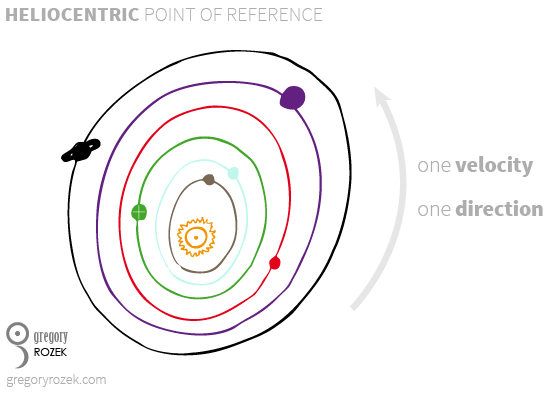
From a heliocentric point of view all the planets move in the similar constant motion and in the same direction. Only a few moons, as well as some eccentric comets and asteroids in the solar system, move in the opposite direction, but not the planets.
However, since the orbit of each planet is of a different size, each one requires different amount of time to complete its revolution around the Sun. That way, when we flatten it within the single circle of an astrological chart, we see the planets as if they travelled through the zodiac each at its own speed.

However, if we change our perspective and look at the sky not from above or the “top” of the solar system (where the Sun lies in the centre), but from the perspective of one of these planets – for example the Earth – other planets appear to move oddly. The planets regularly slow down and make loops, temporarily moving backward against the backdrop of the stars and traveling through the degrees of the zodiac from which they already just recently transited. Then once again, they return to their direct motion.

A popular visualization compares it with highway driving: when you overtake another car, for a moment it seems that the other car moves backwards. This stays true even if they move at the same speed. When they take the turn, the one with the longer distance to cover and will be slightly overtaken by the one with shorter path on that turn. And this is what actually happens with the planets that seem to go retrograde. Keep this picture in mind when studying the planetary diagrams here.
.
How did the ancients cope with those problematic loops that the planets make regularly? They used a concept that may seem surprising to us today to explain it by using a complex system of spheres, deferents and epicycles. It was formalized by Claudius Ptolemy (a fragment of astronomical work the Almagest, Chapter 12. On the Preliminaries to Regressions).

Diagram of planetary orbits, showing the distance from the Sun that each planet turns retrograde in the astrological chart.
When we understand that a retrograde motion occurs when a planet is in a specific orb away from the Sun, it is then clearly seen in the chart. We then do not need an ℞ (or R) symbol next to a planet to know it is retrograde. We just look at the distance that the planet is from the Sun in a chart, and by comparing it with the above diagram, we then make a quick estimation to see if the planet is in retrograde.
The rules are easily memorized: Every planet in opposition to the Sun, is retrograde (Mercury and Venus which can’t oppose the Sun will be addressed later). The orb for retrograde varies from as little as 99° for Pluto, 116° for Jupiter, and 136° for Mars. Essentially, if we imagine that the Sun is at a centre point on one half or hemisphere of the chart, then within the above mentioned orbs, the retrogradation will occur for the planets (excepting Mercury and Venus), that are located in the opposite half of the chart. These orbs are mean values which can vary by a few degrees since planetary orbits are not perfectly circular. The only variation is Mars, where the retrograde area is not around 100-116°, but much smaller, because its reference point is different since Mars is closer to the Earth’s orbit.

Mercury and Venus, whose orbits are inside our Earth’s orbit, are more difficult to visualize in retrograde motion. Actually, without the symbol ℞ or reviewing an ephemeris, it is impossible to guess in what direction they move. Since Mercury and Venus are always close to the Sun, they can never be on the other half of the chart from the Sun, so the above rules do not apply. Nonetheless, when they are on that half of their orbit where it is between the Sun and the Earth, then they are in retrograde. When they are on the other half of their orbit, where Mercury or Venus are not between the Sun and the Earth, then they are in direct motion. Changing direction occurs when they are at the furthest point away (in longitude, that is right or left) by orb from the Sun. That “half” where they are conjunct the Sun by being in front of it is the retrograde half, while when they disappear behind the Sun is direct one half. Though keep in mind that a “half” of the orbit does not measure as half in the measurement of time, because the Earth is constantly moving around the orbits of Mercury and Venus so their respective cycles are more complex.
Generally, for all the planets, it is their relative position in relation to the Sun (and Earth) that causes the retrograde movement and it occurs always in the part of their orbit when they are the closest to the Earth.
Retrograde frequency, duration, stationary period, and point of changing direction in relation to the Sun.
Pay attention that the distance from the Sun where Mercury and Venus change direction may vary by many degrees. Therefore, to guess where these two would turn retrograde for a given chart is not possible.
Why do the planets from Jupiter to Pluto retrograde once a year if they are the slow moving ones with each successive planet having a larger orbit? Let’s clarify this point to avoid some surprising mistakes. Since these are the slower moving planets, then it is the faster moving Sun that makes aspects to them, not the other way around. As we know, the Sun goes around Earth’s sky (with apparent motion) in a year. Therefore, with the exception of Mars which retrogrades biennially due to its closeness to Earth, all the planets outside the orbit of Earth are in retrograde once a year.
We can then distinguish three pattern groups:
- The outer planets Jupiter, Saturn, Uranus, Neptune, and Pluto, as well as all other objects (asteroids and Trans-Neptunian Objects) moving beyond Jupiter’s orbit retrograde once a year.
- The two planets closest to Earth retrograde less often: Mars retrogrades once every two years, while Venus retrogrades approximately once every 19 months.
- Mercury retrogrades 3 (sometimes 4) times a year.
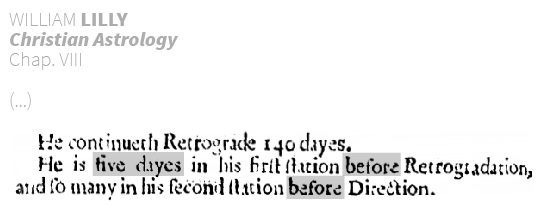
Some astrologers and many astrological applications confuse the delineating point between a planet’s retrograde (℞) and direct (D) movement, thus affecting the definition of a Station, and in addition, what does a stationary-retrograde (SR) and stationary-direct (SD) mean? We can distinguish up to eight divisions of a planet’s cyclical movement from direct to retrograde, and then direct again. But do we need them? How did such a simple observation as a planet changing direction became so complicated? It is from a misunderstanding of physics, and a confusion over mixing the station with the change of direction which distorts the logical definition of retrogradation.
We must be careful not to confuse direction with speed; a planet is retrograde as soon as it changes its direction, and we can see how this works with charts. The Station is only another layer on top of that, and not an in-between state. In reality, no pause happens. The planet does slow down in apparent motion, but it does not actually stop for even a second, so it is always either direct or retrograde in motion. A better quality ephemeris or astrological programs will show that exact moment and will usually distinguish the moment between a planet’s stationary-direct and stationary-retrograde motion.

PART II. THE INFLUENCE OF RETROGRADE PLANETS IN THE ASTROLOGICAL CHART
Popular but not necessarily factual associations connected with retrogrades.
- Mercury retrograde in a natal chart implies an impaired mind, insecurity, or awkwardness. That’s just a common Ego-booster to call what is not comfortable to an observer as impaired. Nothing is being so eagerly, wrongly and unthinkingly labelled by people as intelligence and stupidity.
- Mercury retrograde as a transit brings communications disaster, nothing works out well, only miscommunications occur, and machinery breaks down.This concept is present even in the popular culture (see: Astrological threads in American TV-series). It functions as an absurd, over-determined in its denial, despite some interesting studies which show that a number of prosperous companies incorporated during a Mercury retrograde. In conjunction, electrical catastrophes and communicational disasters also occur when Mercury is direct. It definitely does not help to add the shadow periods: pre-shadow period before and the release period after each retrograde phase of Mercury. Some astrologers see it in the same magnitude of debilitation as the retrogradation itself. This then just leaves us with the idea that half of the year we will experience chaos and mental impairment. For many, Mercury retrograde is the only thing they will focus upon, and they will not undertake any new work when Mercury is in retrograde. Some studies show that those who watch out for Mercury retrograde periods, happen to be the same people who experience the communicational and technical chaos the most (as oppose to successful entrepreneurs, who don’t fear the Mercury Retrograde urban legend), because they are often disorganized all the time and at least they can blame Mercury half of the time. Yet, for a change, almost no one talks about how Saturn retrograde is a potential indicator of times when any new job might just end up being short-term or limited.
- If you were born with Neptune retrograde in the birth chart then you are a soul who incarnated in the mythical Atlantis. Remember that’s 40% of population. Are almost half of the population the incarnation of those mythical illuminated former inhabitants of that ancient spiritual paradise?
- If you were born with Saturn retrograde in the birth chart then you are one of the Holocaust victims from World War II.
- Mars retrograde acts like Venus, and Venus retrograde acts like Mars.
- A retrograde planet behaves like its second domicile sign in planetary rulerships. For example, Mars retrograde behaves like Scorpio, since Mars traditionally rules both Aries and Scorpio (modern astrology left Mars ruling only Aries, and sees Scorpio as having only a status of a co-ruler, because Pluto was given rulership of Scorpio). Few authors use this example in reverse for modern planets where, for instance, a retrograde Pluto is not Scorpio-like anymore, but behaves like Aries.Unfortunately, the concept of primary and secondary planetary rulerships is a relatively recent construct of modern astrology. Traditional astrology did not make a differentiation (the five planets did have one day house and one night house, but they were not regarded as “first” and “second”, nor was this division equivalent to the above-mentioned modern one). However, we might see Saturn direct acting in a strict Capricornian nature, while acting more rebellious in an Aquarian way when in retrograde, or that the suppressed Scorpio traits fit more to retrograde Mars than those of bold Aries, but for the other planets it is a stretch. Our approach to retrogrades would be safer when we limit it to the simple rule that retrogrades act in more inward way, which as a simplified rule works quite well. Making an artificial choice of which domicile ruled by the planet is more inward, is not needed.
- A retrograde planet rules a different sign. For instance, it rules the sign of its natural fall (i.e. Cancer for Mars), or by being debilitated in the signs it is naturally exalted in or ruling it. This approach is typical for some streams of jyotiṣa astrology.
Through research and observation, I find most of these ideas carry no merit from a rational and spiritually conscious approach. This does not mean they are of absolutely no value. For example, a person born with a Saturn retrograde may have had a previous life related to the Holocaust. However, we cannot definitively prove whether such stories about previous life one can find through different methods (from scientific hypnosis to a more spiritual or new age beliefs) are a true memories, or just important symbols from the unconscious soul projected onto our own limited understanding. Certainly, one should not make fixed rules about retrogrades especially if it contradicts recorded observation of complex phenomena.
Focus on natal astrology
The effects of retrograde planets by transits, in an electional chart or horary question and the effects of the same planets in the birth chart are not the same. Simply put, horary, electional and event charts are focused on some concrete yield. The purpose and focus of delineating the natal chart is different and much deeper. Therefore, it is important for me to clarify the role of retrograde planets specifically to the natal chart as a basis for understanding the pure influence of retrogradation itself. This would be the topic I would present in this lecture, because we can understand the world only when we understand first the way how we understand everything, and what we do want see or know, and that what are we able to understand is dependent of something within ourselves.
I regard the retrogradation as a very simple and quick element of interpretation to use, although it is capable of telling us a lot.
Assessing the type of influence by counting how many planets are in retrograde in a person’s birth chart is much easier than calculating their temperament based on using the qualities of signs and planets. The application of retrogradation is much wider. This is one of the few factors in astrology that behave in the same way independent of either house or zodiac systems used (western tropical zodiac or one of multiple sidereal zodiacs). Moreover in most cases, it is usable even in those situations where we do not have an exact place or time of birth. Therefore, it makes a fast and efficient part of the analysis.
How does a retrograde planet act?
In classical western astrology, to reference the Anthology by Vettius Valens from the beginning of our era, as well as the later classical authors, retrograde planets (as opposed to stationary ones) were considered unambiguously detrimental. However, it is not often stated with clarity whether it is terrible in of itself, or is it bad to be on top of another debilitating planet. Nevertheless on the lists of planetary weakness by several authors, specifically Guido Bonatti and William Lilly, retrogradation was always close to the top of the list, and in case of Lilly it was assigned the highest minus 5 score.
Modern astrology stopped stigmatizing the retrogrades and even started to praise them as keys to the transcendence of karmic patterns. Likewise, some of the classical authors of jyotiṣa astrology consider retrogrades as extremely strong and beneficial, which reflects the fact, that when planets are retrograde in the sky they are at their greatest size and brightness.

There is also a connection between retrograde planets and the Moon.
Retrograde planets travel backward through the zodiac like the Lunar Nodes (if we use the Mean Nodes which are always retrograde, not the True Nodes which periodically do go direct when the Sun or Moon pass over either of them).

They are also connected with the Moon cycle itself and its pattern of waxing and waning.
Every planet in opposition to the Sun is retrograde.
 When the Moon is in opposition to the Sun it shines the brightest and is the strongest. Retrograde planets behave the same way. Since they are closer to the Earth, these planets appear larger and brighter. Their influence reaches the Earth in their pure form, and not filtered through ego as happens when a planet is in direct motion.
When the Moon is in opposition to the Sun it shines the brightest and is the strongest. Retrograde planets behave the same way. Since they are closer to the Earth, these planets appear larger and brighter. Their influence reaches the Earth in their pure form, and not filtered through ego as happens when a planet is in direct motion.
A direct planet, like ego, projects its traits onto others, attracting the material events.
Retrogrades act by blocking the external influence of planet. These blockages make the native “retrograde holder” to focus on developing his internal strengths associated with the retrograde planet through a strong inner knowledge.

For example, a Saturn retrograde gives the native disappointments of limiting constrictive structures and authorities through others breaking their trust. In effect, it teaches him to develop the inner freedom of deciding where the boundaries are adequate and where they are not, despite the common norms.

Mercury retrograde perceives what communication is suitable in same unorthodox way, making the holder sometimes reject sharing thoughts or be harsh and incomprehensive.
The other planets render their traits alike, therefore not taking into consideration whether a planet is retrograde might bring a completely wrong judgement into reading the chart.

Jupiter retrograde is disappointed by teachers and religion.

Mars retrograde represses aggression.

Venus retrograde has problems with expressing the love, reducing it to a mechanical nurturance without feelings or warmth. It is supposedly one of the saddest set-ups, because in reality, all humans pursue a soul mate and a person who doesn’t fit in the convention of social relations and sharing emotions could be hard to handle for others.
 Modern planets are assigned a rebellious nature and a connection with transcendence by definition. Therefore in retrograde it only enhance their inadequacy to norms.
Modern planets are assigned a rebellious nature and a connection with transcendence by definition. Therefore in retrograde it only enhance their inadequacy to norms.
Only Neptune in retrograde brings a distinctively different influence. This is a planet of nebulous motives, feeling adrift, dishonesty, delusion and media-related, and when in retrograde, makes a person almost unable to lie as well as create a drama around oneself.
Bottom line, as I showed you earlier on the diagram, a retrograde period is deeply connected in astrological interplay, so any planet in retrograde is not saying to us anything new actually. If it seems to contradict your overall reading of the chart, it should be a warning sign, that you haven’t seen something in your reading of the chart and you should review it.
Of course, the classical planets (Mercury to Saturn) are much more important here. However, any strong planet (on angles, conjunct or opposite one of the lights or the ruler of the rising sign to name the most influential) enhances the importance of retrograde planet. Especially Saturn retrograde strongly emphasized would manifest markedly.
Some universal advice for interpreting any retrograde planet is to listen to and trust your intuition, because once the ego stops predominating, the intuition then flows. If your decision isn’t made in a rush, but worked through self-conviction, then a pleasant outcome is assured.
We should be careful with any astrological rules for those “planets that disobey the rules.”

William Lilly in his Christian Astrology regards Saturn retrograde on the Ascendant as an indication that: the matter seldom or never comes to good. However, the wording used by Lilly was understood in the English of his time which in some cases has different meaning today, and probably referred to the simple fact that Saturn retrograde denies rules. Therefore, what the 1st house signifies will not keep with rules typical to such situations, or the querent may hate adhering to such rules, which all can lead to difficulties, but it does not automatically lead to failure regardless of the circumstances. For comparison, let’s look at horoscopes with Saturn retrograde on Ascendant – some examples of how the attitude towards sexual taboos caused different results, depending on the rest of the horoscope.
In horoscopes of both Alain Bernardin and Michal Witkowski there is Saturn retrograde rising. In addition, it is in Cancer, where normally Saturn is in detriment. So, is it terrible?
Bernardin became famous for establishing a revolutionary cabaret – Crazy Horse Saloon – where the dancers performed naked as in striptease clubs, enriched artistically with contrast lighting. The whole enterprise made him wealthy with a multitude of followers all over the world.

The other one is a Polish writer, who became famous with a book that laid bare the secrets of the gay community.
The ruler of the ascendant – the Moon – in both charts is on Medium Coeli (fame) in conjunction with Jupiter in Pisces where Jupiter is exalted (great fame). Therefore, Saturn retrograde had not made them unable to achieve anything. Saturn acted by simply breaking the structures connected with the body and persona (1st house) instead.
Look also at the opposite example where the ruler of the Cancer rising chart – the Moon – is also conjunct Jupiter on an angle, but this time on the opposite IC (home, family) in Virgo, where Jupiter is in exile. This is the natal chart of a boy, also of different sexual orientation, which in this case hadn’t been elevated as a source of fame, but instead became a reason of being expelled from a foster home. Saturn is also retrograde here, but not on the Ascendant (in fact it’s even in his own sign, in Aquarius). The harm was done by other factors here.
As these chart Comparisons show, the retrograde motion of Saturn on the Ascendant, even when also in its sign of exile is not striking out the chances for the native to progress, so there are more important elements in the chart that might impair the native.
PART III. THE NUMBER OF RETROGRADE PLANETS IN THE NATAL CHART
The best method to understand how retrograde planets operate is by analysing the charts of people who have no retrograde planets in comparison to those people who have all the possible planets in retrograde in their chart.
McCormick and statistical research
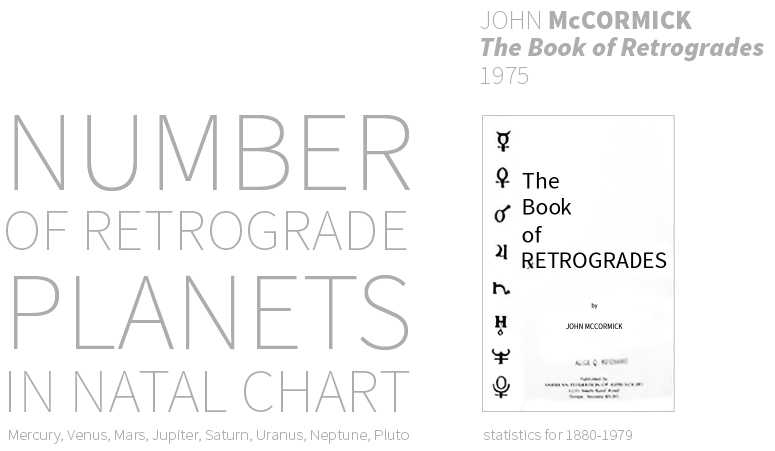
Articles on retrograde planets in the natal chart are quite scarce, and most of them simply quote the calculations of John McCormick, an American astrologer from 1960s. He came to conclusion, that it is not the quality but the number of retrograde planets that allows us to distinguish different types in people. His calculations used the modern eight planets from Mercury to Pluto. The Sun and Moon are excluded since they never retrograde.
What emerges from the statistical recalculation of the ephemeris, is confirmed in research on different groups of people.
Statistically, at least one planet is retrograde more than 92% of time thus making for only 8% of time when there are no retrogrades in the sky from the Earth’s perspective. The highest frequency in the population are those people born with two or three planets in retrograde. The result is quite similar to normal distribution. However, to have no retrograde planets is still more likely than to have five in retrograde. Six or more planets in retrograde is quite rare.
For those who have less than the average two or three planets retrograde (zero or one) the world moves quickly. The person wants to experience more, but feels an inner uncertainty from the enhanced activity.
In contrast, when there are more retrograde planets, the world appears to slow down, so there is less inner uncertainty. McCormick himself was very cautious about people with six retrogrades. He reported to know only two people with them, and regarded them as true loners. About those extremely rare cases with seven retrogrades, he assumed it must be impossible for others to understand them.
A statistical examination of astrologers seems to indicate that they often tend to have one more retrograde planet than the regular distribution pattern shows. Astrologers who write about retrograde planets usually have very little of them. For instance, McCormick has only Uranus retrograde, though it is located right on the IC.
When no planets are retrograde
Since there are no retrograding planets only 8% of the time, the frequency of a birth chart without any retrogrades is limited. Therefore a chart without any retrograde planets should be considered more the exception than the rule.
People who are born with all the planets including the Sun in one half of the horoscope are very likely to have no retrograde planets. Yet, Mercury and Venus need to be checked to see if they are also direct.
This is not very common type of the chart. If not only all the planets and the Sun are in one half of the chart, but the Moon would also be in the same half, we will get an even more special type of chart, indicating very focused personality. Even without analysing what is in which sign, I can quickly assess that this person is sensitive and insecure, but intelligent and with a streak of stubbornness.
People with no planets in retrograde (not just those with special tense charts like above) want to achieve as much as possible and move forward just like their planets. They are able to put much effort and passion into their goals. Some astrologers comment that having no planets retrograde makes these people plainspoken and transparent, which is not necessarily true. It is better to say that these natives feel complicated. And as much as it may appear so to them, they seek an outside opinion, in the belief that it can bring to them an inner understanding since the other seem to see them more clearly then they see themselves.
Maximum of retrograde planets – the difference between traditional and modern astrology
McCormick calculated statistics on retrograde planet frequency for a span of one hundred years. I expanded these calculations to include all the 21 centuries of the Common Era (CE), and an interesting conclusion emerges when we compare the time periods when the current number of the known modern planets from Mercury to Pluto were retrograde to those periods when the classical five planets of antiquity were retrograde (Mercury to Saturn).
If we begin counting from the 1st century CE, then eight of the modern planets never retrograded simultaneously, but we did have seven planets retrograde for 19 short events that lasted from four to 64 days. If we review these retrograde series over the 21 centuries, the five classical planets do retrograde concurrently, however at a lower frequency than seven of the eight modern planets going retrograde. Thus, for this analysis, the modern system is less ideal. As one who works with ancient astrology, I am happy to report that all five classical planets can and do retrograde concurrently thus reconfirming its ancient, but consistent methods as complete. However, as seen in the table above, the periods of retrograde for both the seven in the modern and the five classical planets are extremely short thus rare, with wide gaps of usually one to several centuries between occurrences. It is not surprising then how small a fraction of a percent of a population will be born with a maximum number of retrograde planets.
The last time that all of five classical planet were retrograde was in the distant year 1542. We do not have many accurate birth charts for people born then. However, we do have a few people:
Though not much about their personality was reported.
However, I was able to find one chart with all classical planets retrograde. Moreover, it is of the famous astrologer, the legendary Nostradamus.
ASTROLOGERS WITH MANY RETROGRADE PLANETS
In his chart the Lights (Sun and Moon) with both Mercury and Venus retrograde are near the MC, although not in aspect to each other by orb (except with a moiety orb by Bonatti that makes Venus and Moon in aspect). The opposite side gives Mars retrograde, Jupiter retrograde, and Saturn retrograde all within 8° to the IC, opposing the Sun, so they are as close to the Earth as possible. Jupiter, the closest planet to the IC, is exalted and conjuncts both debilitated malefics (in Cancer, Mars is in its fall while Saturn is in its detriment). These three planets rule all the other planets plus the Ascendant. For example, Jupiter retrograde rules both Mercury (planet of astrologers) retrograde in the 9th house of higher wisdom and North Node (which many see as the souls vocation) in the 12th house of mystery. Is this enough indication to be a great psychic mind, and widely remembered as being synonymous with prophecies about war and destruction?
However we have two versions of his birth chart. The one above and the other for exactly a week earlier.
The first chart mentioned is recalculated based on his date of death and the number of years, months and days he lived (both inscribed on his tomb), while the other chart comes from Chavigny, a biographer of dubious reliability. Some researchers suggest that he tampered with the true date of birth of the prophet to make Mercury – the planet of astrologers – be in better essential dignity (cf. article at CURA – in French). In the chart for that date, Venus is stationary and not yet crossed the point of change of direction, but this would still be close to the ideal five ancient planets retrograde.
With so many retrogrades he is to some degree similar to astrologers with five or six of modern planets in retrograde. They usually use some elements of astrology, mixing it with hypnosis, soothsaying, numerology or other divination techniques, because that’s how they view them – as interchanging sources of inspiration that don’t work well in isolation and one should not limit oneself to only one. Hence most of the astrologers with many retrogrades won’t stick to its rules. Therefore, their work might appear as not as devoted to astrology in its strict sense although their understanding of astrology might actually be deeper. Nostradamus, for instance, was a serious astrologer. He even spent some time researching and revising the detailed calculations of retrograde motion of planets, correcting the previous tables.
Françoise Hardy (6℞, ♀ ♂ D – direct) – an iconic 1960s French singer and actress who had childhood problems with self-esteem, though never treated her famous jobs with ego that would want to prove something, and eventually became an astrologer (see more on her in another post)
Examples of other horoscopes of well-known people with many retrogrades. All of them, like Hardy, have Venus, the planet of art, in direct motion.
Roy Chapman Andrews (7℞, ♀D) – the American explorer whose adventurous life was the model for the character of Indiana Jones.
Anna Zugno (7℞, ♀D) – Italian cyclist (an example for a group of athletes with seven retrogrades, and one of few people born on April 30, 1984, and another is presented towards the end of this article)
Cheryl Burke (7℞, ♀D) – American dancer who openly shared a story about being molested in childhood.
Jean and Auguste Piccard (6℞, ♆ SD – stationary direct, ♀D) – twin-inventors
Frank Sinatra Jr. (6℞, ♂ SD, ♀D) – singer, and the son of famous singer Frank Sinatra, who in 1963 was kidnapped for ransom, then released.
Jean-Claude Jitros (6℞, ♂ SD, ♀D) – French fashion designer (creative with leather just like a one non-famous creative man with 7 retrogrades)
Angela Davis – she was one of two names McCormick did find to have six retrograde planets, yet she actually happens to have only five (☿♀♂ direct). Still, she’s quite interesting individual. A communist leader, the FBI put out an all points bulletin on her with people hiding her all over the United States. Davis was a radical feminist, and a fighter against the racial discrimination of Afro-Americans.
Cassius Clay, later on known as Muhammad Ali (6℞, ♂ ☿ Direct) – an extraordinary legendary boxer and defender of Islamic religion and the rights of black people. 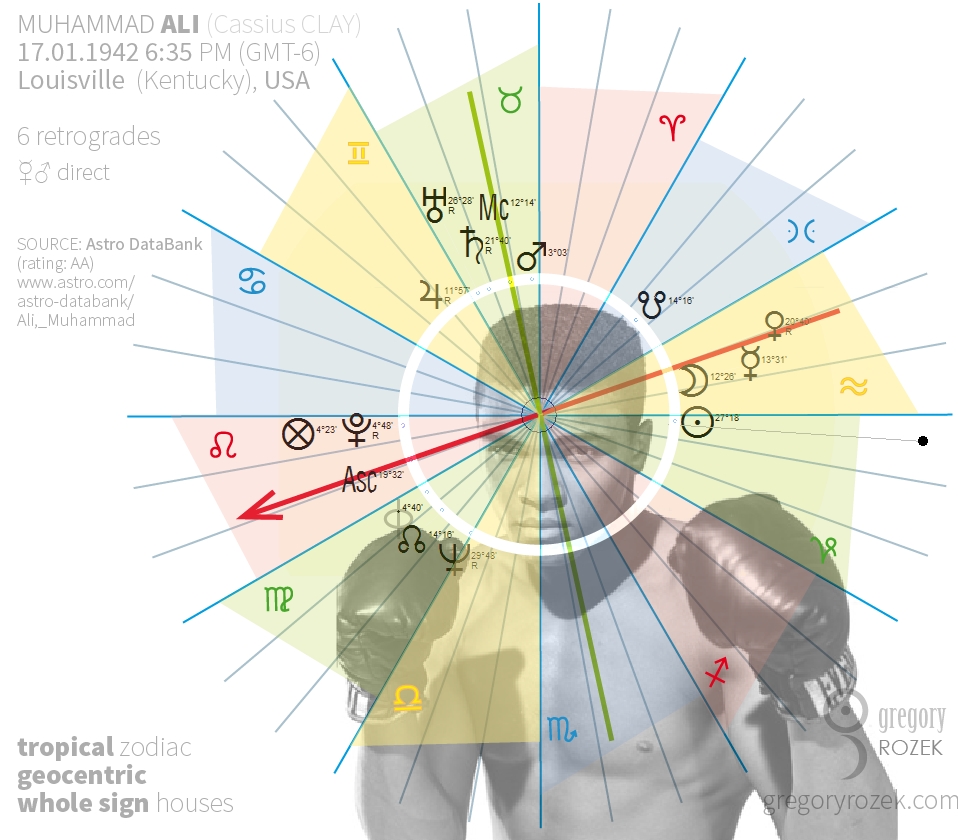
For a change, he doesn’t have Venus in direct motion. But of course he has Mars direct in 10th sign of fame and ruling the 9th sign of religion. In Hellenistic astrology no sign can see the adjacent signs, so a planet in an adjacent sign to it’s domicile cannot freely control it and can get frustrated about that. Because Venus does see both Aries and Taurus, the matter of religion did come to surface, but retrograde Venus on the Descendant axis which is in square with her domicile in Taurus, where the Mars, obviously resulted in bad politics and problems in career. When looking at his chart take into account which planets are retrograde and which are expressed in typical mundane “direct” way.
“NORMAL” PEOPLE AND THEIR ABNORMAL LIVES.
An extremely private and withdrawn lesbian with six retrograde planets (except ♀ and ♂) who was never more intimate with anyone beyond cuddling and kissed only once. She never used drugs, but was unhappily in love with junkies. A Pacifist and a ghost-child, always at the background, silently watching. She witnessed her many relatives battered or raped. The very same abused women treated her like a maid. After failing to hang herself, she ran away from them to live in shelters. Only close friends can experience her silver tongue – the third sign (independent Aquarius) is ruled by independent retrograde Saturn in the 11th sign of friends. She won’t let strangers know much about her or label her. The Lord of her Ascendant is Jupiter retrograde which lies in 12th whole sign house in Scorpio – the hidden and debilitating place where it doesn’t see the house it rules: the first (the helm of life it should steer) and 4th (family and roots).
A story of one American family that had a dangerous car crash with a school bus driving at full speed. The chart for this moment had Mars Rising in his domicile (in Via Combusta) in trine with Jupiter retrograde (the only retrograde in the chart) in the house of long and extraordinary journeys, conjoined with Moon in Cancer where both are extremely dignified. Though they are also in tight opposition to a stellium of Venus, Saturn and Neptune in the house of short journeys, with Uranus in the same house (I use whole signs as houses like elsewhere, but Porphyry, Regiomontanus and Placidus cusps give the same positions here).
The mother who was the driver has one retrograde planet ended up with a steering wheel in her chest almost reaching her heart. Her rebellious daughter with no retrogrades was completely crashed into the dashboard. But two sons, with five and six retrogrades respectively, survived the accident relatively well. The younger with five Retrogrades didn’t even get a scratch and stayed conscious whole the time, so while in the ambulance he overheard that the others died. In his birth chart the Sign of Virgo is rising with Moon.
The ruler – Mercury – is together with Sun and Mars in Cancer all in direct motion. He also has Jupiter-℞ T-squaring Saturn-℞ in 3rd house in Scorpio and very well placed Venus on the North Node in 9th. Parallels to the chart of the accident are clear. Although he experienced many dangerous situation later in his life, the highway accident was not among them. I won’t talk about his experiences, but let’s just say he has exactly the same planets retrograde as Angela Davis.
The other boy with six retrogrades had his brain exposed because the skull came off in the car crash. Doctors proclaimed he would be mentally retarded. But he came out of the hospital as if nothing ever happened. Although bullied in childhood, he became a jolly and likable man, except by his family who never got along with him.
After months of hospital care, the surviving victims of the car crash came home. But despite coming so close to death, the atmosphere in the house was far from healing. The mother, who sought perfection, always cold to her family and disliked by people, acted like nothing had happened. There was no discussion about the accident at all. She went through a cycle of repeatedly divorcing and remarrying the children’s father, who was in fact a sexual maniac, who was also diagnosed with bi-polar disorder, schizophrenia and other disorders.
MIKKHAIL – A NATAL CHART WITH SEVEN RETROGRADE PLANETS
Finally, I like to share the chart of the most interesting person I met – Mikkhail (Michael) – an individualist living in Poland. He has the maximum possible number of seven retrograde planets and according to other sources is also a very advanced old soul with a very harsh karma to be stuck with (or “an old fart” as he calls himself), that has incarnated here for the last time to prove something, with many master numbers in numerology.
When Michael was being delivered, the doctors had to ask the mother’s parents whose life to save, mother or child’s, because one of them won’t make it. He was bottom-down in the green waters – seemed dead, but after a resuscitation a lively birth was announced. The mother survived as well and everything seemed to end well.
Nevertheless, his family life was and still is a hell, who are unable to express kind feelings to him, and pin the responsibility for everything under the sun on him, constantly digging up dirt on him, expressing complaints and accusing him of everything he did and did not do and of what other people did. Despite these difficulties, no one can challenge his intellect and resourcefulness which enables him to survive the assaults from the family, false friends, serious diseases, death of those close to him and being dragged through the courts by swindling companies (after a success in court he began fighting through the courts against other fraudulent corporation. Everything that concurrently with being constantly mobbed by mixed-up irredeemable people seeking help (also karmic) from his strength and wisdom. Still – because of his way of behaviour, developed to not let the others destroy him completely – ordinary people prejudge him as a monster or a madman. With time, they all however have to finally agree with him in pain and with a tail between their legs, because they need time to see through their ignorance at the things he spots and perceives instantly, long before they happen. However since these truths are too dirty to be admitted by these people, that they almost always start being overdetermined in their denials again, leading to a renewed effort to torture him even more bitterly, misusing the strength they developed thanks to his kicking their inner demons and blockages. Only animals, little children and few adults are able to notice his inner peace and concern about blinded humans’ fate, behind the facade that people seem to fear. Others perception of him is restricted to not believing he’s suffering in process of fulfilling the inner mission of his soul forces him by punishing him when he’s too soft on people, because it sounds so unbelievable to them that they can only think he’s exaggerating, completely watering down what they are not secure with to accept. It is difficult to tell if anyone is able to fully understand him, that away he’s from the rest.
In my Polish lecture I gave special space to present his chart and retrace his atypical life with the use of progressions and firdaria, which allow us to quickly and elegantly interconnect his chart stigmatized with had karmic work. The attendees had an occasion to see in practice whether I am right about what a common reaction to a person with the highest number of retrograde going into important topics is, because Mikkhail was a special guest of the lecture.
NOTE: A separate article about Mikkhail’s story and his chart analysis is in preparation and will be posted on my website, therefore if you’re interested, please revisit my website, contact me or follow me on social media to stay tuned.
SUMMING-UP AND FURTHER CONCLUSIONS
People with many retrograde planets experience the feeling of being different. They often feel unnoticed, like living in a different dimension. When they speak up publically for a serious cause, nobody seems to listen (or at least no one seems to be able to respond). The discussion regarding retrogrades usually goes on among people with very few retrogrades leaving the serious questions of these people unnoticed. They feel like the society doesn’t want to accept anyone deep, self-aware and just considered “abnormal”. These “Retrograders” attract energy in some imperceptible level. Others with serious problems seek their help. So many disturbed and blocked people or addicts come to their life in succession, like they would subconsciously know that only these “Retrograders” can bear with them without hypocrisy and believe in a way out for them more than others do. Retrograders seem to experience bad situations, within their own homes often full of physical or psychological violence, or difficult childhood outside home or parents who don’t have good relations (or at least an immigrant parent). They are also prone to accidents. It’s clear that people, as well as blind fate cannot function normally in their presence. They recognize that many others would not survive if put in their shoes. They consider suicide very often. I don’t know of anyone who ended their life, but their feelings and thoughts of leaving this world are frequent in their minds. However, this seems to be of different quality from what typically is imagined when one thinks of suicidal tendencies. Try imagining the world calming and slowing down for these people, with others around rushing around with unimportant ideas, before making an attempt to see them being open to die. However with time, when they develop maturity, they find the reassurance within themselves. So far, this applies to all people with five, six and seven retrogrades that I was able to research the natal charts.
However it is not the outside symptoms that connects these people but a deep similarity that is almost impossible to picture. The material events act for them as blockages that allow them to develop internally. However, it is hard for them to express verbally, because the customary words don’t match with what these people see and how they perceive others. Although every one of them is different, there’s an elusive common denominator. Strange events are only there to enable these people to achieve the strength of character that lets them survive the inner experiences that would defeat others.
I feel like I’m from some other planet or other reality. I see this world like I’m in front row of a circus where people do strange things over and over like a hamster in a wheel not able to see beyond what they do. I can’t help anyone because they can’t understand what I mean and usually will express being mad at me for that or ignore me totally or just treat me as I need psychological treatment. So I keep most of the stuff I see for myself.
This was my attempt to shortly summarize how is it to be a person with many retrogrades. Each subject with the exception of one person agreed with the descriptions. The one exception in time agreed after being initially opposed, but it shows how hard it is to pin that down.
To look from the other perspective, let me report, that I also have seen some people with standard two and three retrogrades saying things like, “this definition is not true, because I feel the same.” Apart from the obvious fact, that I haven’t stated that others cannot say similar things, it is an interesting example, because it is a characteristic of some people with the standard number of retrogrades who, as I stated earlier (and people with many retrogrades experience that all the time), whenever they see or hear something from or about people with many retrogrades, they tend to not listen what is an actual deep meaning of that and if they decide to comment upon it, they would just say something about themselves that is actually irrelevant to the topic. It is lke they subconsciously deny these people’s existence or right to be more conscious and need to downgrade it to some mundane triviality, for which human language is best suited. And many people feel the urge to express that they are smart and they see others as stupid too. But that’s not what these people think. They know the answers, they are in no doubt what should be done and who they are, they don’t want to prove anything. But they were born with strong burdens that won’t let them change the world or humanity. Born in a golden cage that by isolating them makes them see things clearly. They care about the world, not so much about attention. If anything, they would appreciate understanding and compassion, but that’s what they can actually fulfill themselves. Although each one of them is different, and it might be hard for some people to accept a person who is far away from being a Buddhist monk, or to be enlightened at all.
One of these Retrograders (April, who is an astrologer with six retrogrades) brought to my attention the similarities of my rundown to what the words of Jeff Green (the father of Evolutionary Astrology, who has 4 ℞) had inspired her to: Many retrograde planets helped one to individuate, in reflection – seeing things for what they are and getting out of “the Matrix”. And when there are no retrogrades, a person tries to fit in and makes more projection instead of reflection. It’s hard to not agree with her.
The Old Souls of astrology?

Numerology has the Master Numbers, whose holders are gifted with greater inner wisdom; The Journey of The Souls has its Old Souls (the most matured set of incarnations of the soul). One can’t help to see the people with many retrogrades as an analogy here.
However, it wouldn’t be responsible to create a new theory of classification of people – creating a language of labels for the unnameable things, because it immediately corrupts that knowledge. But it’s hard to miss a substantial difference between people who have 5 or more planets in backward motion and those with just two or three such planets.
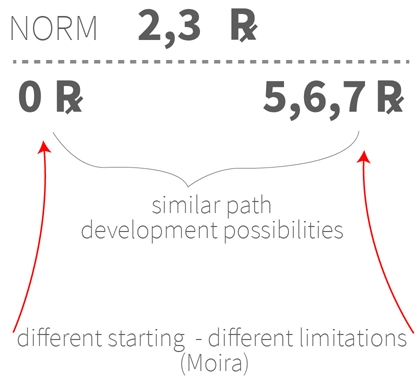
Similarities and differences between people with many retrogrades and those with none.
At the same time it’s hard to leave out those who don’t have retrograde planets at all. They are dissimilar to the “norm of majority” (that is the standard two or three retrogrades) as well. Although they are on the other extremity of the distribution graph shown earlier, than those with many retrogrades. Being extreme and atypical, they go the same road in their inner life. But the starting point for them is totally different.
What might help here is a comparison of the classical treatment of retrograde planets with the modern one (which is also quite similar to Vedic approach). A theory of my own, which in my opinion allows to understand why people What might help here is a comparison of the classical treatment of retrograde planets with the modern one (which with no retrogrades and those with many retrogrades share the same possibilities (e.g. of a spiritual development), but experience totally different restrictions imposed in their charts (by Moira – fate).
The ancient “masculine” spirituality, that is characteristic for the patriarchal civilization focused on development and aim of the soul, condemns the retrograde motion. The fact that the source text that survived to our days contain only that kind of thought, may be partly due to the fact that astrology back then was mostly performed for the rulers, who’s aims were materialistic and required actions (keeping the lands under the regime, detect the traitors, build and conquer) so it was more electional and horary in nature, than wanting to explore one’s insides. Yet it doesn’t mean the great astrologers of the antiquity had not analysed the soul and blind fate – we know they did, sometimes to a great extent. But can we really say that in the centuries where the astrological delineation was almost exclusively male-oriented, for the rich and cruel mostly – it was pure and not subject to that worldview at all? On the other hand there’s a stream of spirituality, that originated from Asia, which is now popular in modern astrology, that in the contrary we might call a “female spirituality.” The spirituality in this view is passive and in sync with what already is happening (as oppose to “masculine spirituality” thinking, that you weren’t born with the fulfillment and craving to achieve it by effort or tricks). The “female spirituality”, what is obvious, for a change treats the retrograde planets with praise.
But in reality both of these methods on their own are a faulty limitation (if a view is antithetical to the other view, it is not covering the whole of the reality, but just the part of it, that fights with the other part, so it is actually an image of reality fighting with itself). Only taking both of this ways of perception into consideration – and seeing them as the spirituality based on the cycle of activity and passivity (an action aimed to make oneself develop by reacting alternated with tuning in with what already is present and not acting). That, as a wholeness gives us a true picture of reality.
The closing conclusion should be clear now, I hope. In an accurate understanding of retrograde planets I do see a great cognitive capacity of human and the world, and I feel it’s my aim to explore them further.
IF YOU LIKE WHAT YOU READ YOU MAY CONSIDER A PAYPAL DONATION
to support my further study
ACKNOWLEDGEMENTS:
Many thanks to everyone with whom I was able to interview – especially to Mikkhail, April, Allan, Joseph and Adam. I would like to also thank Tomas Kiedos for help with recalculating AstroDataBank data of sportsmen and especially Nicholas Theo for commentary assistance when I was revising this text.
COPYRIGHT NOTE:
Copyright © Gregory Rozek
Text as well as the diagrams, tables and illustrations are property of the author – Gregory Rozek. Parts of it may be shared, as long as you provide author’s name and website address:
© Gregory Rozek, en.gregoryrozek.com/retrogradeplanets/
or if space is small: © Gregory Rozek, gregoryrozek.com
and inform me when you do so. To obtain permission for printing and other means of distribution, you have to contact me first.


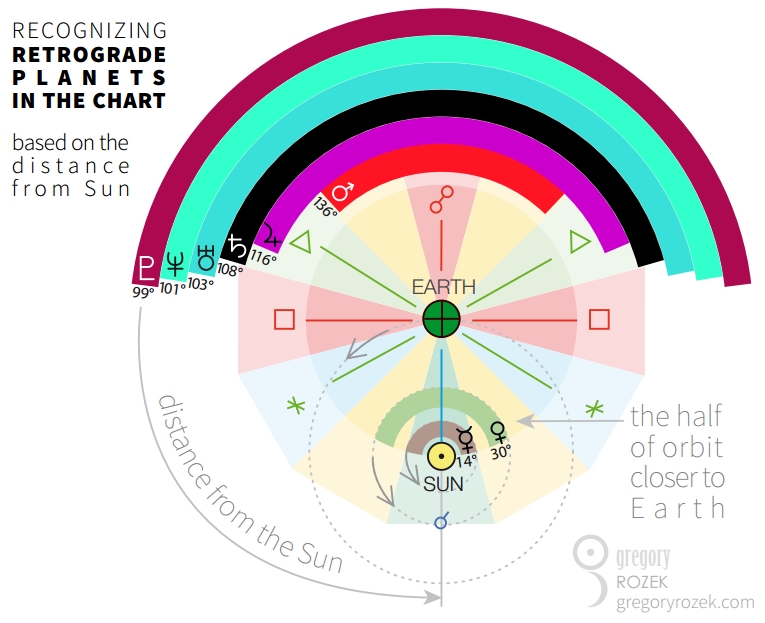

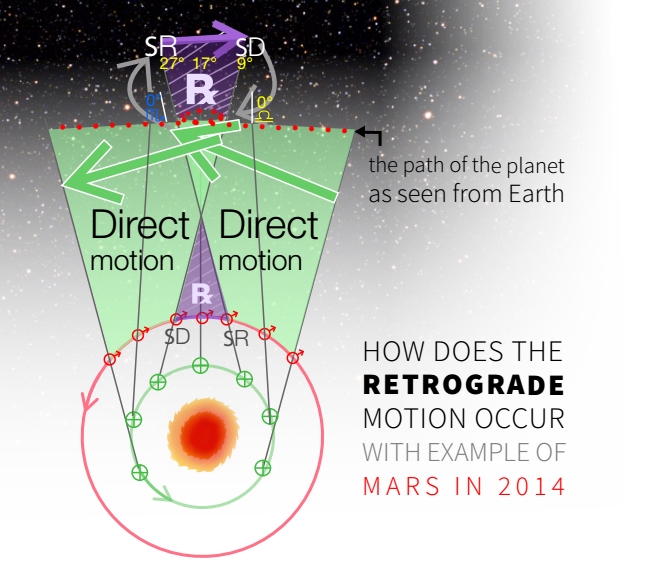


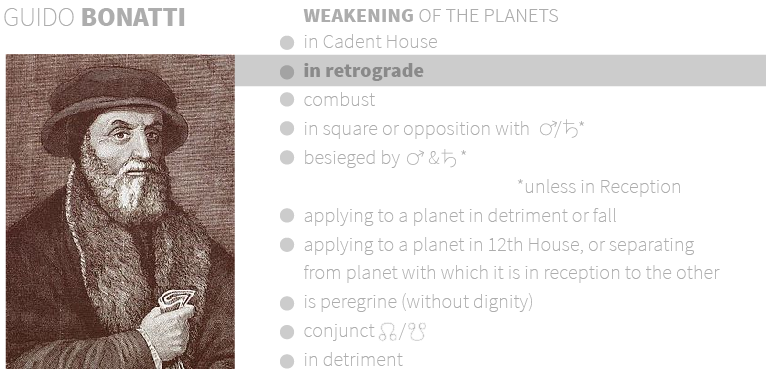
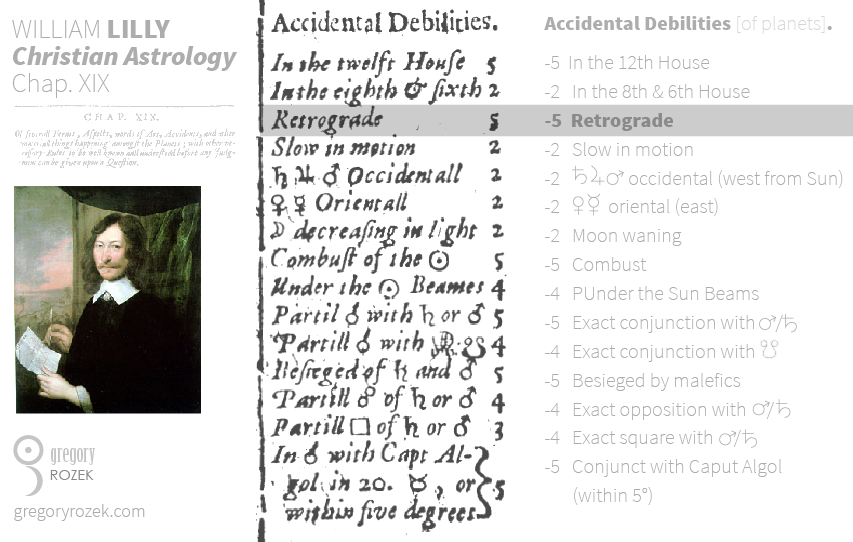
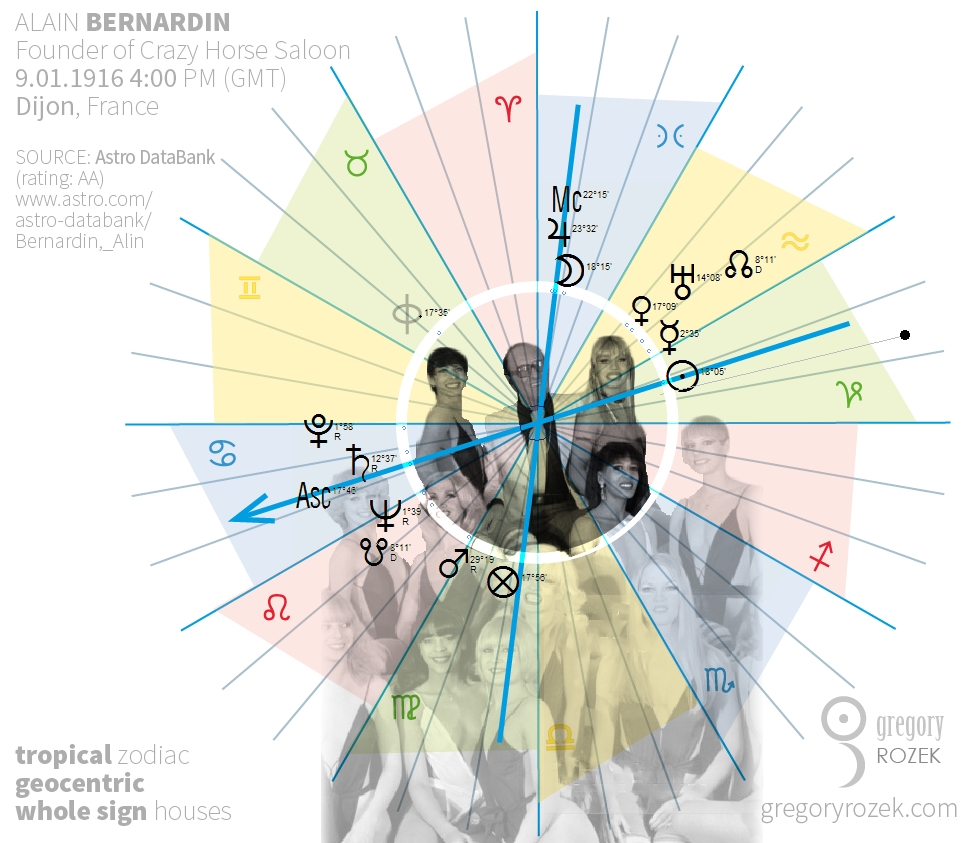

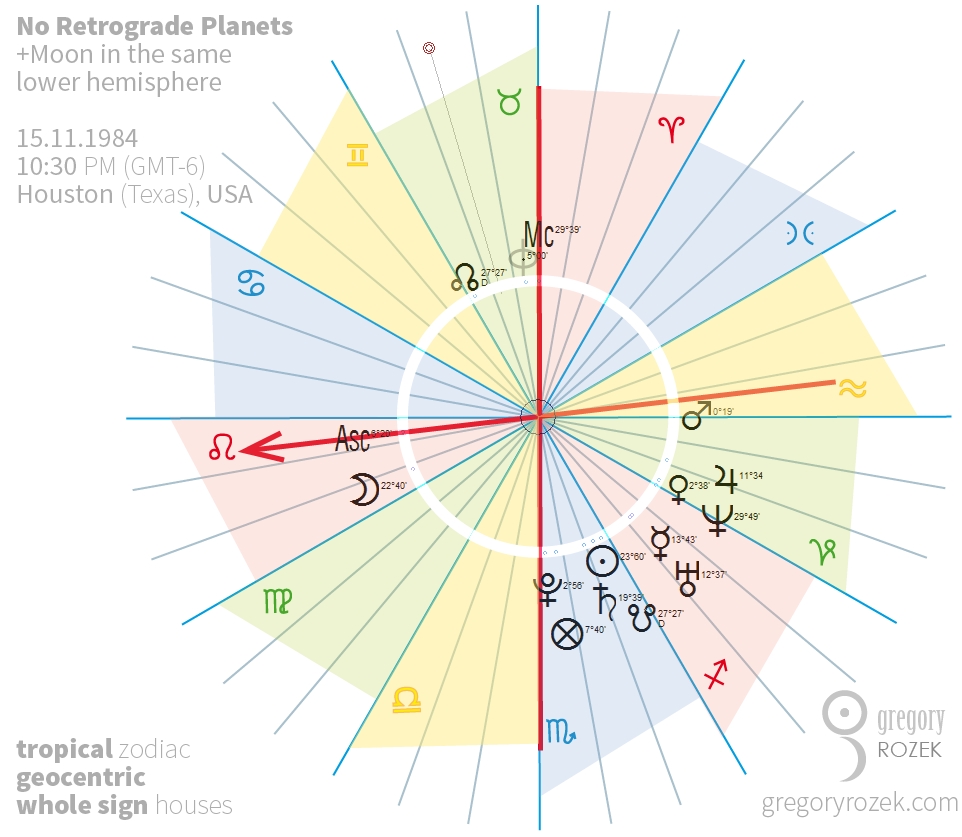
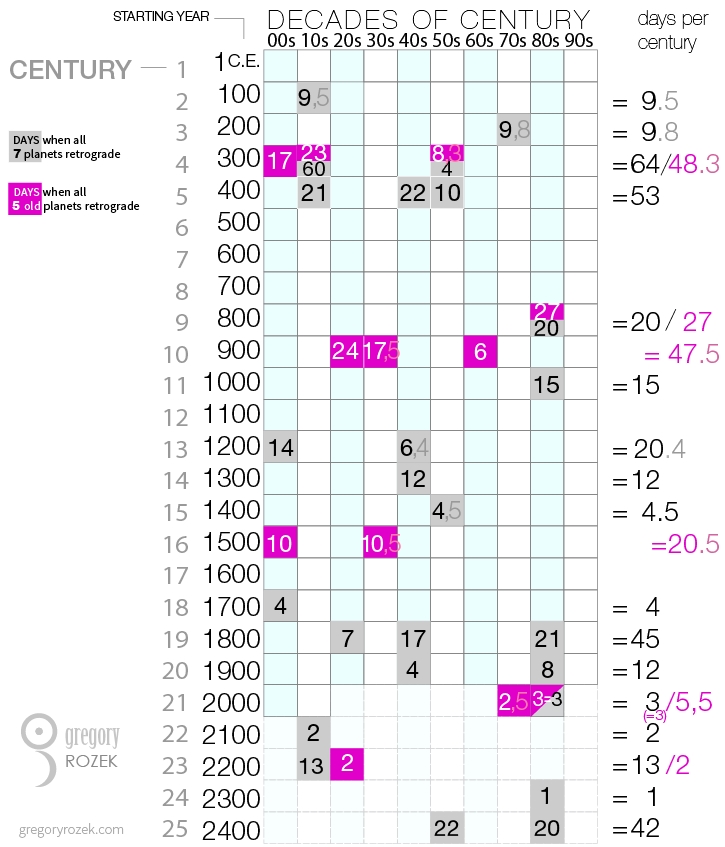
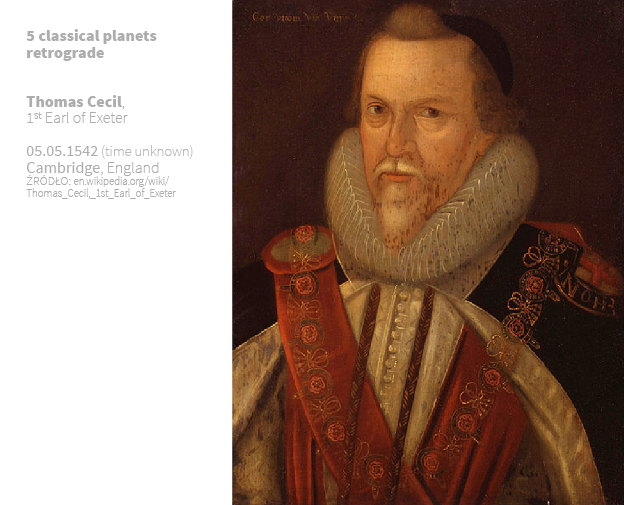




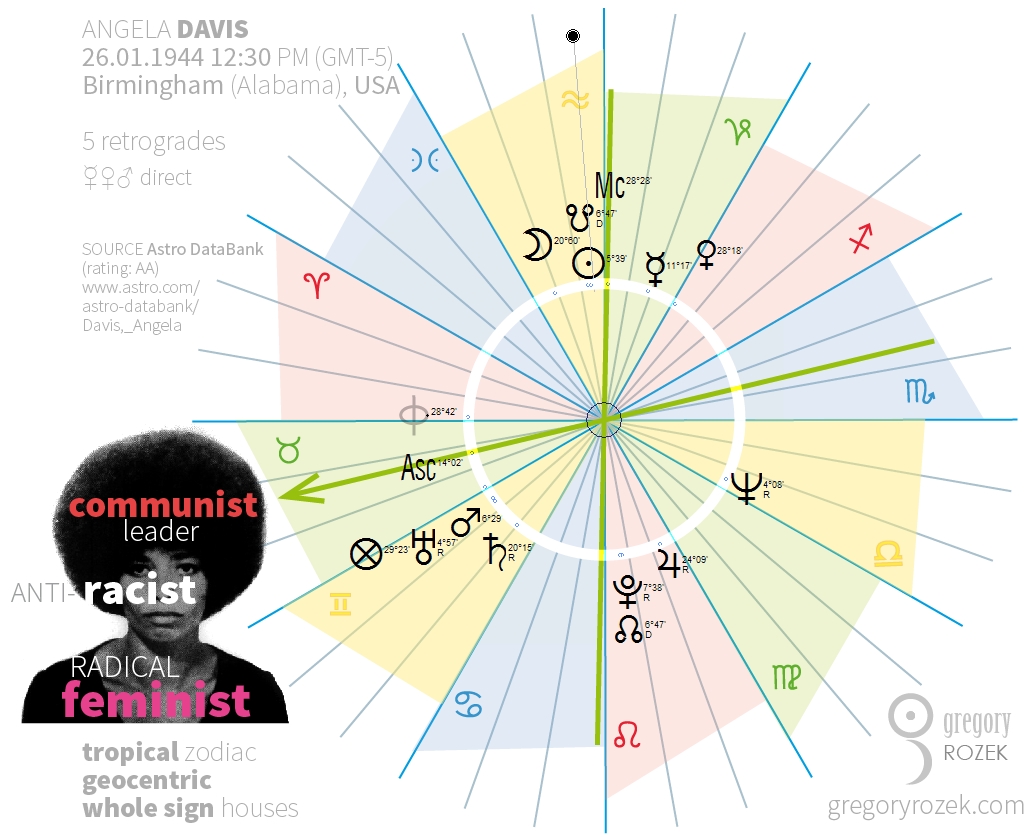
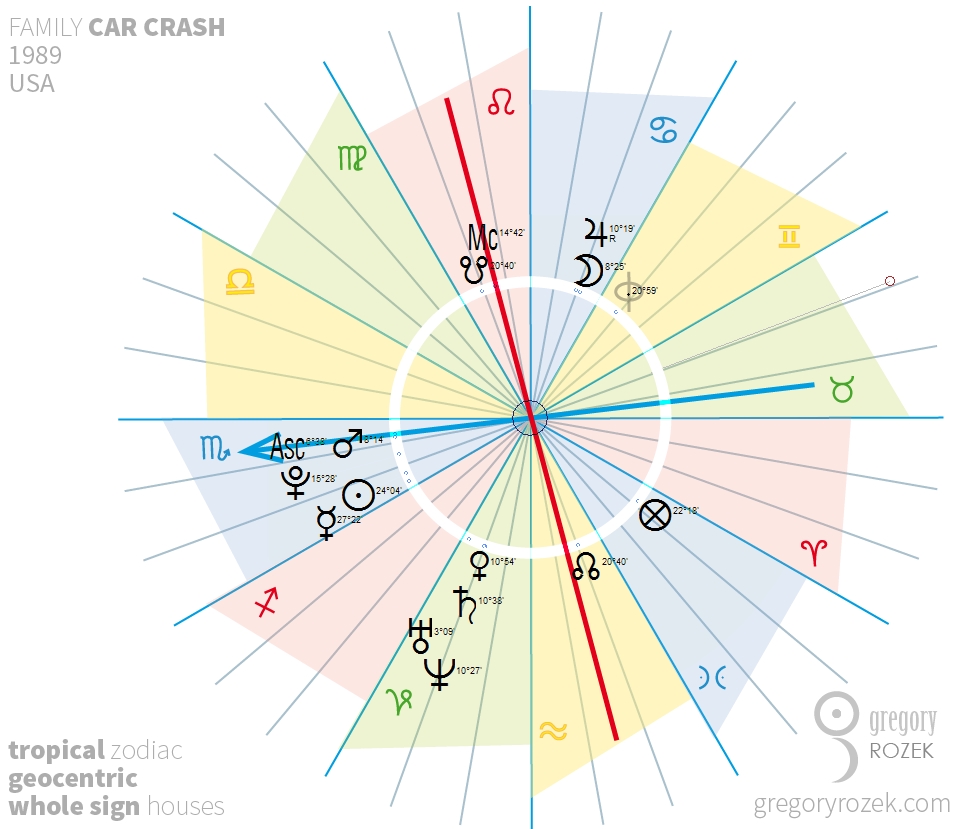

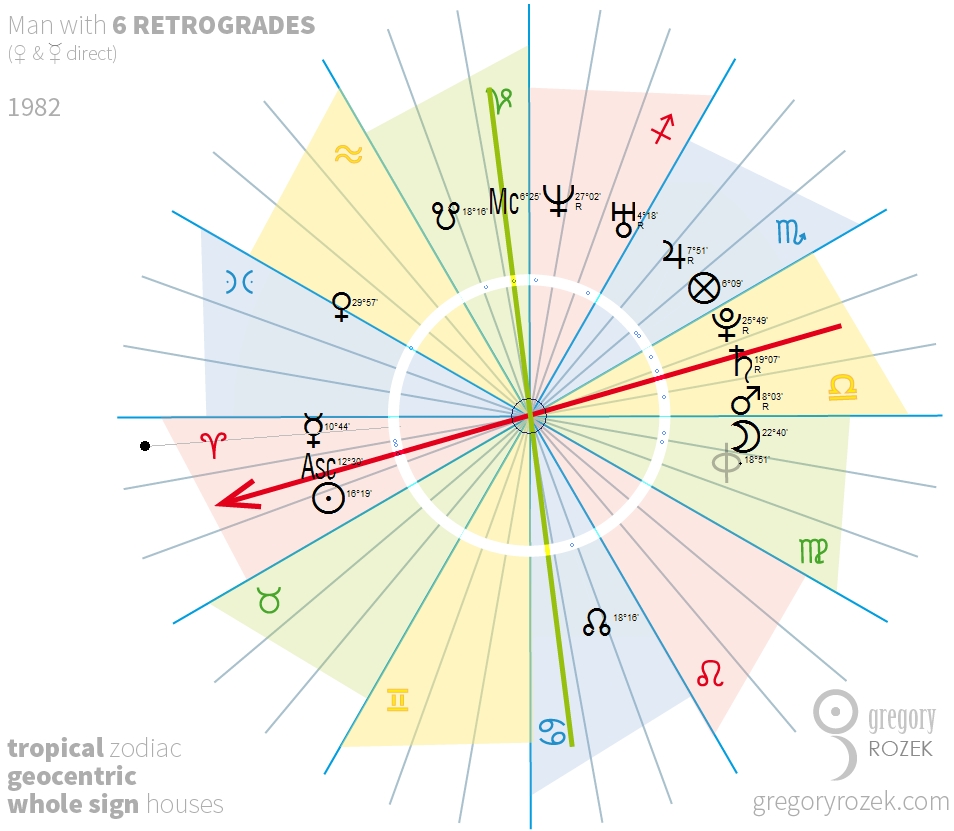
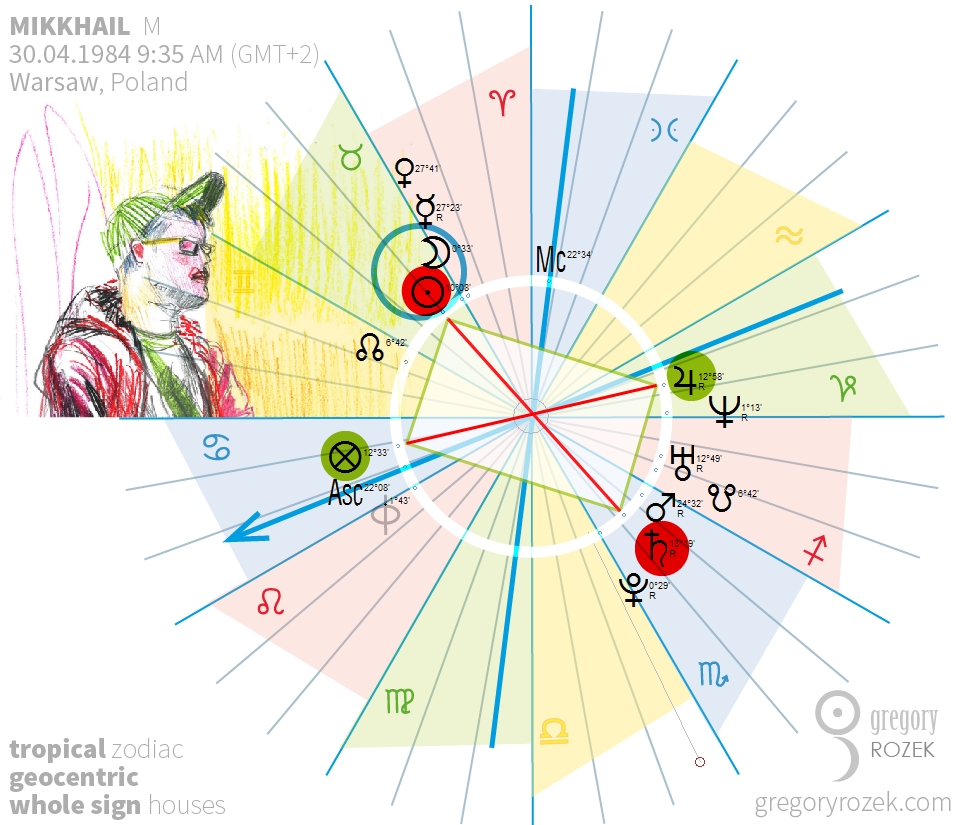
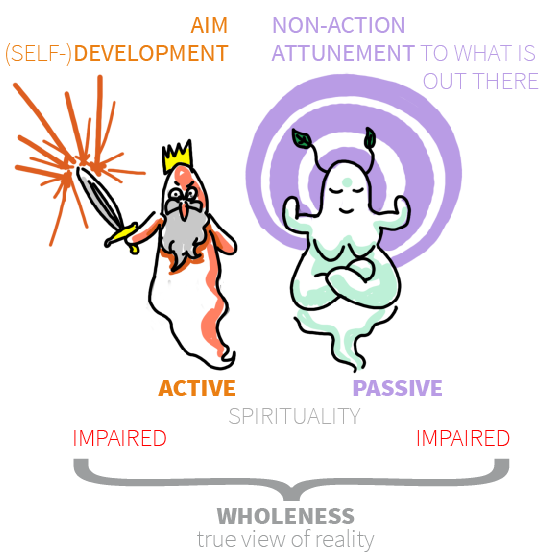



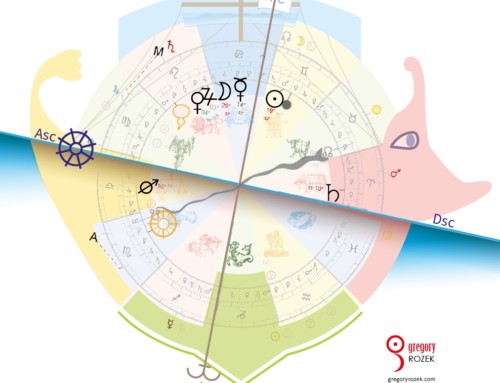
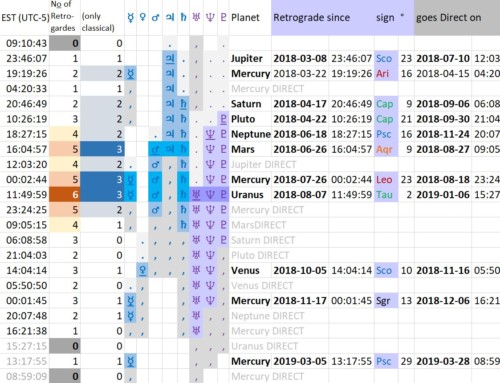
Awesome article… Great to finally find an in-depth article on Natal Retrograde Planets… I have 6 planets (Mars-Pluto) and Lilith retrograde… Thank you!!!
My pleasure. Thank you, Ashley. And good luck with your set-up!
I have a question about the people who have 2 or 3 retrogrades and feel the same as the people with 5,6, or 7. Are they somewhat enlightened or just happen to feel similar? You see, I have 3 retrogrades. One in Saturn mentioned as a victim of the Holocast, Jupiter, and North Node. I just now noticed these in my chart and I’m amazed at such detail given here, I will probably look at more of your articles.
It’s really down to the individual level – looking at each birth chart individually. However often the first comment a person with 2-3 retrogrades would voice is “I feel like that too, and I don’t have many retrogrades, so it’s stupid”. This can be partially the definition of assuming what the standardized majority feels is what someone else must be feeling like, like there is no other option (“They claim they feel like an alien, I think I can say I feel like an alien, must be the same thing!”). And partially, say 6 retrograde planets are not required for described scenarios. Which means, there can be other reasons, also astrological equivalents. But if so many retrogrades do occur in one’s birth chart, this is almost a guarantee for the situation to happen. I describe the number of retrogrades as a quick and effective rule of the thumb, because it is not talked about by astrologers at all, as well as somehow the majority of those with more retrogrades say to agree with the whole premise. And most of those with 2-3 retrogrades does not care about the whole topic (as the premise suggest they will do). I am fairly okay with people with fewer retrogrades to see themselves partially in this “retrograde world”. I would be worried if there would be a backlash from 6 retrogrades people saying it’s all wrong (though I would actually want to learn from that). Astrology is always requiring the judgment of an individual astrological chart, as like in nature, you need a certain combination of factors to be really certain that a correlation will occur. Saturn is the number one factor that has a lot to say here. For example, if you have a lord of the rising sign to be Saturn retrograde in opposition to Sun or Moon, or your lord of the Ascendant is conjunct such Saturn – it gives a strong “retrograde narration”. And one more thing – a really retrograde person (many retrogrades, Saturn retrograde making hard aspects to the key planets ruling the soul, certain Moon phases, etc., including equivalents in numerology) is going to have a different tone in their internal energy and how their energy interacts with the rest of the world. Or in other words: suppose you cannot feel comfortable with a person and want to avoid them – depending if a person has a said strong retrograde combination of factors or just 2 retrogrades being – say Uranus and Neptune in a cadent house – the emotions about that person would come from a different place within you. To one who has more retrograde stuff in their chart, these distinctions are more obvious, and for someone with a more standard birth chart this sound more woo-woo, so they would simplify certain things to be “the same” in their experience. We also have people with no retrogrades, for whom it fluctuates, is much more nebulous – at one point they seem to grasp the difference, but a few moments later they are not sure if there is any or perhaps if there is a difference maybe they got it the other way around – that kind of feelings. I like it better if I’m explaining this when doing someone’s interpretation, and can address their specific birth chart. But I’m hoping I might get an idea how to generalize the details for the general audience…
Amazing, amazing!!
Both text and layout/graphics.
Thank you very much!
Thank you so much for your beautiful, detailed work on the light above and for sharing freely below! You are powerfully brilliant and benevolent, may your karmic desert be just and plentiful!
The highly controversial Teal Scott-Swan (http://www.tealswan.com/), known in spiritual circles as “The Spiritual Catalyst”, has 6 Rx planets in her natal chart. She suffered years of horrendous abuse as a child. She is also (or claims to be) an extrasensory.
I’m also beyond excited because, in a synchronistic turn of events, I just discovered I know someone with 7 retrograde planets, a former distant colleague of mine. I’m considering getting in touch with him to interview him, so I’m eagerly waiting for your article about Michael and his story.
Thank you for sharing, Maria!
Just be prepared that he might be extremely reluctant to share his inner life.
I am sorry I am not being able to deliver the promised remaining materials as fast as I would like to.
If you’d care to share some more of your observations (for the unrestrained sharing of opinions on other I assume rather via confidential private contact), I’d love to hear that.
Best Regards
Gregory Rozek
EXCELLENT PRESENTATION!
CLASSIC WAY EXPLAINED ABOUT THE RETROGRADE PLANETS!
THANKS
Brilliant article, Gregory, very well-researched and well presented. I’m an astrologer/psychologist (for 34 years) with the five outer planets Rx in my chart. I recently made contact with a woman with six retrogrades (Mars and Jupiter direct), and whose Moon is Void of Course. Fewer than ten percent of natal horoscopes have V/C Moons, and hers is halfway through an unusually long (24 hour) V/C period. We have similar professional backgrounds, went to the same grad school ten years apart and she is insightful and self-aware. She is a self-described loner, but we are nonetheless considering a LTR. I wonder if you have encountered this combination (6 Rx + V/C Moon) in your research, and if you have any comments?
Thanks,
Bill
Thank you, Bill, for pointing out to the void Moon, and sorry for the delay in my answer.
I agree, on the theoretical level the standard delineation of Moon being void of course seems consistent with my findings on retrogrades. But here are some problems with considering them the same way:
The definition of void (and wild) Moon has changed or developed several times in history of astrology.
Retrograde movement is an obvious astronomical fact and is not dependent on any theoretical concept like where is the border of the sign of the zodiac, where the void of course stars and when ends, there are no circumstances that can alter the state of being retrograde, as opposed to void Moon which is dependent on where in the sign it lays (not always*) and what aspects does it make – as opposed to sign borders, orb of the void Moon to consider and what is the theory of aspects you are using with this void Moon.
*For example in Hellenistic Greek period of astrology, which predates any other tradition that utilizes void of course (like Arab, medieval and so on), Moon was void when no aspect will happen within next 30 degrees, therefore disregarding the sign borders. Also the system of orbs was different back then. So you get different results in different system when considering “Moon is void in this chart, or not?”
Therefore, simply based on just that, research on void moon would require much more work, since to examine a theory (as opposed to the effect of obvious event) one needs to examine all the possible versions and interpretation of this theory, within multiple theoretical frameworks, to be sure of anything.
Also going a one step further, it’s not that easy to follow void of course Moon (or any other planet) as it is to count the retrograde planets (of course we can take different objects to consider in counting retrogrades and built a theoretical systems on that, but you get the point where I’m going here, I hope).
And finally: basically the void Moon is more or less being an unaspected planet (special kind of, but still). Therefore, what it does is highly dependent on individual chart analysis.
I wouldn’t be so eager with making generalizations about retrograde planets either, but the case studies made impossible to not see the connection.
But also, the historical astrological doctrines are not that eager to use void of course for the Moon in the natal astrology, as they do for horary and electional astrology (the role which the Moon plays in different chart types was different).
So, taking all of that into consideration, that’s worth looking at when you looking at the chart of person being insightful and withdrawn form typical human thinking, which would obviously require personal judgement over a single chart.
Still, I would risk a starting-point theory (that is to be checked with personal judgement in each chart) that the Moon being in the last balsamic phase can be responsible for what you described – as a single indicator yet to be checked, that is.
And I also know of at least two charts of such people with Moon being in strong 1-degree orb harmonious aspect with the Sun (not in balsamic phase) and with other planets also. So I wouldn’t make a “no-error guaranteed rule” of any of these.
But I agree, with many retrogrades, void course would make the Moon “less busy” so internal life may like it to have, so to speak.
Thanks for the thought. Is that OK for you?
Regards
Gregory Rozek
Fascinating article. I’ve got the five outer planets and ascendant’s ruler (Mercury) in Rx, and while not a *complete* hermit, I’m pretty darned close. Thanks for helping us retrograde types to appreciate our sometimes extreme (and therefore problematic!) introversion.
Great article. Informative and enlightening on such a rare subject. I knew there was more to retrogrades than all the negatives associated to them by most articles. I have my natal Node plus 7 planets retrograde (Venus direct.).
Thanks.
Hi Gregory! Before I read that you did graphic design I was admiring your logo. I don’t see many astrologers/graphic designers, and I thought how well you presented this article with illustrations dispersed. Thank you!
I’m sure you’ve looked into many charts with Rx planets, but I wanted to add that I also acutely feel the way you describe for those with many Rx planets. I have 6 Rx, including chart ruler Mercury, and only Venus and Pluto are direct.
I told my mother when I was a four years old, “I’m in the wrong place. I’m not supposed to be here”; she tells me that I said it as if it was a sudden and horrifying realization, and it gave her goosebumps. I don’t think I’ve ever left that state.
Anyway, thanks again for posting this! There is not a whole lot of information about retrogrades, as you said. It’s good to know we’re not alone. 🙂
Thank you so much Gregory for this enlightening article. As a person with 6 RX planets myself, it’s nice to know that the feeling of life constantly throwing me a curve ball is somewhat explainable. In a way I suppose my unfortunate coincidences made me feel rather crazy without any indication as to why I suffered them. I used to think that this life was some kind of karmic balance I was brought here to fulfill.
If you would like to discuss the series of my life that has unfolded I’d be happy to do that with you, for both greater knowledge of myself and for your studies. Please let me know if you’re interested!
Anyways, I thank you again. You are a wonderful writer with great thoughts and I hope you continue to investigate your astrological interests.
Sincerely,
Alice
Hello,
This is a very well informed site.
My daughter has 6 rx planets, all but Venus and Pluto.
She’s 28, teaches 11th and 12th grade English, married, extremely social and travels a lot; including a 28 day backpack with her younger sister in Europe.
She’s very pretty, intelligent.., not brilliant, she had to work for her grades and organized
I believe her childhood was happy and fulfilling and normally dysfunctional. 🙂 also filled with lots of tradition.
I’m an extreme novice in astrology but found it very intriguing with her having 6 planets in retro.
I was told by a very good astrologer that me and my husband’s chart, indicated we were meant to be together because of either a child or grandchild we would have.
Of course, as every parent, we hope that our children do something great. Of course, I am very blessed… I have two daughters which contribute to our society by volunteering and fundraising.
I admire your hard work and passionate love for astrology.
Diana …. Thank you for this article.
Very interesting research. I was born a day or so prior to “Mikkhail” mentioned in your article, and I also have a Cancer Ascendant. I have 6 retrograde planets.
Mikkhail’s outlook towards life is similar to mine: I likewise feel like an alien visitor observing a strange world whose inhabitants are peculiarly self-defeating in their behavior. It’s like watching a slow-moving ant colony where the ants are oblivious to greater things.
On a side note: I fell in love with a female who has no planets retrograde whatsoever. She was one of the most driven, action-oriented individuals I have ever encountered. I suppose it was an example of a mostly “projective” individual encountering a mostly “reflective” one.
Thank you Alex. I indeed observed it is as common for those with many retrogrades to couple up with people with no retrogrades just as common it is for them to attract others with many retrogrades. But actually even more common, simple because of the fact, that it is easier to stumble upon a person with no retrogrades (8% of people) than anyone with 6 or more. But also, because those with zero retrogrades are more open to reach others, as opposed to those with many retrogrades who have tendency to be more restricted in opening up. If such a partnership occurs, I always suspect they share one or few strong points in their charts and their relation is based on working out some so called karmic things.
Thank you for sharing that, and I would contact you.
Gregory-
Congratulations! Your website dazzles. Unique covalence: committed scholarship, verbal acuity, visual alchemy and devotional service.
Allure and charm – grounded in – fact and diligence.
You hit every mark.
It sings.
Thank you.
Diana H
Florida
USA
Thank you for the read. I have been wondering about this topic as I have all but venus retrograde. 7 retrograde planets and cancer rising. chillingly accurate for me.
Me too! Omg I’ve been dying to find someone else. When were you born? I was may 4 1984
Thank you so much for this article – it is wonderful to hear that there are others out there with so many retrograde planets. I have 6 natal retrograde planets (venus/jupiter direct) with cancer rising (aries sun) and 6 retrograde by progression (mercury/venus direct). It is genuinely comforting to know that there are others of you out there thinking/feeling like me.
Gregory I would be very interested to talk with you privately. I’m a 6 Rx.
I have six Rx. I completely identify with the sense of being misunderstood. I often find that my deepest intuitions go unsaid for lack of an audience.
thank you Gregory – thank you very much. blessings..
no-body sends broken-open greetings to Mikkhail
*
Thanks for this. I am a beginner in astrology & have 6 planets retro as well as true Lilith. Your article inspired me to research further!
I am just starting to read and understand my chart, and I seem to have 6 plants in retrograde, incl. Venus, Mercury, Uranus, Neptune, Pluto. I have been looking for an explanation of that, and this article was very helpful.
I haven’t felt the feeling of slowing down (maybe because I have a grand trine in fire) but I have definitely felt the effects of a retrograde Venus in my personal life
Awesome article! I have 6 RX planets and master numbers in my birthday too. I have life path 33 . 11 and 22 is In my chart making my 33 life path. My name has master numbers too. I also have a stellium in my 12th house as well. Can you can imagine the self awareness ? or the deepness of my being? I had a near death experience when I was a baby but came back to life according to my mother. I had unusual spiritual metaphysical experiences growing up. Life wasn’t that easy growing up but looking back and reflecting back, I can see how one of my dreams foretold the darkness I was going to embark on in journey here on this planet Earth. And that I would have an invisible force with me doing its best to help me. But I never paid much attention to that dream and its meaning until years later when I had a spiritual awakening in my early late early 20’s. I just got out of my Saturn return not too long ago. I’ve had psychics who have told me that I’m a very old soul. Yes, it has been a lonely journey but am stronger and wiser now. Thanks for writing this article. Much Love <3
I just want to say, that this article really helped me. I will be donating as so as I get the chance. I have 6 retrograde planets, and for my whole life, I feel no one appreciates me, or even understands me. It’s like I don’t understand why, when some people say things, that I find so limited, gets so much recognition and praise. I just feel I go ignored. I previously started my own YouTube channel, because I was tired of being silent. I have Mercury, Saturn, Jupiter, Uranus, Neptune, and Pluto retrograde.
I cried as I read your article because I felt as if you understand me! It’s like I have felt I didn’t want to be here anymore because what’s the point. Even in love, I feel I have no luck. I just look for true interactions that’s it and all and people run away. I feel so cursed. I feel like people think I’m abnormal and I don’t have an ideal life. I wrote a book, and I’m trying to finish and get published. It’s hard for me to communicate verbally, because it comes out wrong. I do excellent in writing, and artistic manners. I’m studying astrology now, and I am happy about that. As I am getting older, I am coping better with who I am, and understanding a lot more!
Thanks to you, I finally feel free, and I have the final pieces to the puzzle of who I am! I feel like, I know I am not crazy now!!!!!!
People always come to me for help, and they feel as if I will not judge them, but it’s hard because I can’t get the same support in return. I now, feel, after reading this article, I finally received the support!
Thank you from the bottom of my soul 😊
My pleasure for being able to help, Alicia. Thank you for sharing and good luck.
What you described is the experience of my life as well… I relate so much it’s crazy. I have 7 planets retrograde. Could you let me know what your YouTube channel is? I’d love to check it out.
Thanks and all the best to you!
Thanks. www.youtube.com/user/GregoryRozek or the youtube icon on the bar on top of the page
Thank you for this amazing article, it is an important contribution to astrology, I have read many Astros articles this one is the most convincing, satisfiing,
Many thanks for the beautiful article. I have 7 planets in retrograde and would like to further discuss my birthchart and story with an astrologer. Please let me know if you have any suggestions. Thanks again!
Fascinating article. I just discovered today that I have five retrograde planets in my natal chart (and yes, my Venus is direct!): Mercury, Mars, Jupiter, Saturn, and Pluto. All that you describe above is definitely true of my life. Thank you so much for this article–I find it quite validating!
I have 7 retrograde planets in my birth chart also. Venus is direct. Mars and Neptune in my 12. Born July 12 1986 at 8:40 pm. Most of what you said rings true to me. I would love to get a reading on my natal chart
Hi, Indigo. Yes, your birthday is within about 2 and a half day of 7 retrogrades – the occurrence of such that was under strong retrograde Mars opposing the Sun and Venus square retrograde Saturn.
For a chart reading also the place of birth is required. I will email you regarding that.
Thank you for your input.
We’re twins! 7/12/1986 ( I’m 1:46 AM – New Jersey) except I have no planets in the 12th just my node all alone out there…lol I would love to start a support group for all of us highly sensitive retrograde folk! BTW that’s how I always feel…highly sensitive. In a weird way though. I’m the one in the group that says “can anyone else smell that” before anyone else notices the smell. I have always felt like I’m on a slightly different frequency then others. Maybe it’s my 0 degree Virgo Venus (one of the few planets not in retro, but the one I feel pain from the most?) with my Cancer sun. I think that’s my true karma- I feel things so deeply emotionally, but the expression is never adequate :/
Anyway, I would love to chat more about this subject if you’re interested. Thanks so much!
Jennifer, hi! I was also born on the same day than you! 12-July 1986 but at 5:40 am in Ecuador. I have therefore also 0 degree Venus and I guess our charts must be pretty similar. Would like to get in touch Via email???
Hi Indigo and Gregory. I was born also the same day, 12-July-1986 5:40 am in Ecuador… it’s the first time in all of the time reading astrology that I find, 1. Someone who was born on the same day I was born and 2. I find out an explanation that resonates within me about my 6R planets. Direct planets are Venus and Jupiter for me.
My life is such a journey, I’m always the person who does the unconventional and as you mentioned in this article, the rest sees me as the one who can dare to do something and that they would never be able to replicate the same. I have had deep awakening experiences since I was 7 or even before. Somehow I understand the inexplicable in the universe and don’t need to question things even though my mind knows there are “illogical” phenomena’s, my soul is at peace with this.
I’ve gone through life transforming experiences on and on and I’m convinced that more is to come and feel equipped to this. I feel life is a journey of self realisation, awakening and becoming your real self…
I would love to talk further with you, and maybe with Indigo too, so we could exchange experiences and analyse our charts and life history and paths?!
Hi very,very good. New light in a very old theme.
Hi (again) Gregory,
I started astrology readings when my astrologer told me that my Grand Trine pattern (in 4th/8th/12th in air signs) isn’t something special…!? Then i found that i have two of them ( first is a kite pattern-in air signs) & the second in water signs. I also have a Minor Grand Trine (fire/air combi) and 2 T-squares both natal & by progressions and finaly a Mystic Rectangle but nothing (according to her) was remarkable enough. Nether of course my 4 Rx planets (sorry guys i am mumble, considering 6 or 7 retros) but i still was like an alien with no answers and more confused than before. As years goes by i discovered that,
A) she was lazy and
B) she was jealous (and i was like ATM f😢r her). I am learning astrology by my own and i read about 12 hours per day just to find out why i feel like Mickael.
So,l was looking for karma ( and dharma), my Rx’s and what the f..k to do with my psycho familly. At this point i want to add 2 things:
1st) Rx Neptune indeed can’t stand lies but also when is Rx you have a feeling of constant guilt, specialy opposite of the Sun. Usualy without a reason. If by progression is the Only Rx planet (like my pr.chart and some of my friends) you feel like “anyone can read you” and a lot of people will try take advantage of you. Even more when their Sun is in 0/45/90/135/150/180 degrees with one or both your Sun/Neptune aspect. I honestly don’t know why this is happening.
It’s like you have a sign in your forehead with the words: victim or Stupid. My advice is DON’T be 2 nice or 2 kind. Politeness is a virtue, not a weakness( some people love to think that).
2nd) when a person have in his/her natal chart a lot of planets in water signs regadless if there is/are direct or retrograde then he/she often have the suicidal “recipe”, special when the Moon,Saturn,Pluto are involved, with or without aspects between them. Saturn is the worst.
Also with just one Rx planet (from Jupiter-Pluto) not personal one, the person love his/her loneliness. Is a new phase in his/her life who can sincerly enjoy when is a progression after a bunch Rx planets from his/her natal chart. The redeemed new YOU how can do anything ( O.K. almost anything 😉 ) all alone and still have fun. So in the meantime you already haved learn to be friend with your self. I don’t mean that you are anti-social but you don’t have this feeling of loneliness even in crowded room. Of course the world outside is still in slow motion but now you are (a lot) more wise. The phrase: Everything For A Reason have not just a new meaning, but “Make sense” for anything & everything you have been through in your life. For good or bad. Maybe you don’t realize it now, but there is a purpose. After all you (we) choose this life. You must punish and be punished. Even our familly and our lovers and friends carry this. And there IS a big plan from Cosmos ( greek word= Κοσμος or universe) or God (if you are believers) for all of us. Some people do realize this and some don’t. In Ancient Greece belived that if in your natal chart only Kronos = Saturn was Rx then this life is your last past mistake and when you die you are leaving “clean & free” from this world…..and you are ready for the next life (in earth) to make new karma. In modern astrology some astrologers belive the same with Pluto cause is the last (karmic) planet. On the contrary if the moon Nodes ARE direct in your natal chart (but in progressions and/or Solar Returns too) then this is the most “heavy” karma. Is like to spend a lifetime just to be a “Tool”.…! In sort you will learn absolutely nothing…and you HAVE to .…replay…the song! If you have ever observe people with direct nodes and from 0-2 rx planets they think & act like they are divine creatures and a gift from God ( to us) the humanity. They are the most missoriented and they are never wrong ( they love to think that about themselfs), they honestely belive that until.…one.…day,they don’t!
Anyway, i think a have a lot of heavy *soup* and at some point i love to have your opinions for my chart if you want it too.
Birthday 31/05/1975=17:25(GTM+2)
or if you use summer time(18:25 GTM+3)
To help scorpio rasing 13.10′
23E48 longitude
38N05 latitude
Maroussi,Greece.
Thanx for the reading.
Still very good.
Hi, Midheaven44
Thank you for your input. These are some valid points. Neptune is the most obvious, yes I should have expanded more on the individual effects of each retrograde planet.
Regarding the personal charts it’s better to contact me directly.
Best
Gregory Rozek
Hi Greg, I think I have 8 retrogrades including rahu and ketu i my chart. What you’ve written in this article is absolutely true.
My DOB is 08-June-1988 ,9:45 PM , Trivandrum,India.
one more 7 retrograde here. 13.7.1986. ain’t i lucky.
Hi Gregory,
Do you think people who have a lot of retrogrades in their natal chart can subconsciously pick up on that energy in others? My grandfather and I both have 5 natal retrogrades and we’ve always had a strong relationship and can understand each other better than other people can understand us (I’ve felt misunderstood most of my life– likely due to my retrograde planets). My first serious relationship was with a man with 4 natal retrogrades. And a coworker of mine has 5 as well, and we seem to get along better than other coworkers get along with either of us. Not sure if those are all coincidences or evidence 🙂
Thank you!
I found this very interesting! I have 5/6 planets in retrograde (Mercury, Venus, Saturn, Uranus, Neptune and North Node (don’t know if that counts), I also do have 4 planets in 12th house (Sun, Venus, Mercury, Jupiter). Reading a lot of astrology it would seem I’m destined for horrible things, haha, but I’m not. It was harder when I was young, but lately I feel more and more on my true path. Though I must admit, I do not quite understand many things in this life… Like the cruelty, the insane need for power, the need to lie… And others seem not to understand what I do not understand, haha 😀
Thank you so much! Definitely true!
I have 6 retrograde planets: Mercury, Venus, Uranus, Neptune, Saturn, Pluto and a few asteroids as well. Sun: Aries, sage Moon in 29 degrees Aquarius. Left handed. Lesbian. Rh negative. Definitely been a difficult lifetime. A period of celibacy during awakening (4 years). I have read that the retrograde planets have a divine influence on the soul. I wonder when there are many retrogrades, if that is indicative of a twin flame soul due to the maturity level and the ability to bring in gifts and talents through the retrogrades from past lifetimes.
If anyone wants to check out my birth chart:
April 14th 1985 10:14pm
Fort Lauderdale Florida USA
This article was extremely insightful. I have six retrograde planets with Venus and Mercury direct. I have a Pisces Ascendant and Venus in the first house. Sun and Mercury in Taurus. It’s been a long, hard, and drawn out life. I’ve lived through suicide attempt and subsequent spiritual rebirth. I just ‘get’ things and often have felt like I was crazy because what I know is often dismissed. I’m a gifted writer of poetry. I have the ability to channel the horrors of life and convey beauty in its expression. That’s how I deal with the alienation.
I have been searching all over the web for 7 retrograde occurrences at certain dates. I want to know between 2037-2045 if there is any 6 to 7 retrogrades. I have already found one 6 R; 17 Dec 2037. I wonder if you could help me or direct me towards someone that could. Thank you.
In that span of time the retrograde planets count comes to maximum of 6 at the same time 14 Dec 2037 11:46:38am – till 18 Dec 2037 3:11:32pm UTC/GMT time. Mercury Venus Mars Jupiter Uranus Neptune.
So you hit within the only 4 days-long moment that is there in this period. 2034 and 2065 are two closest moments when there is another 6 retrogrades. Next 7 retrograde planet at the same time since 1986 will be only in the distant 1982 (as shown in the table of centuries, though I was analysing the 1982 situation only in the video in Polish, sorry). No 7 retrogrades any sooner!
I wonder why such date in the future? Could be 3 types of reason for looking that.
GR
Hi Gregory – Thank you for this well-researched and thorough article about retrograde planets in the natal chart. Prior to this I had only found shallow explanations. Interestingly enough, my art practice has developed a very “spiritual” theme. (4 Rx planets)
I know this might sound silly, but reading your article I couldn’t stop crying( in a good way). Your article is just amazing. I have 5 planets Retrograding. I was born a few days from your Polish Friend Mikkhail (5/17/1984 at 14:45 ) . I knew I was different since I was little. but there was no one to explain why. I have and had such a hard life that even recently I just screamed and said to life.. to take me ..I was done. but this explained so much to me. Astrology is a subject that is so beautiful and so amazing. It is the only thing that understands me and I find comfort in it when no one does( weird isn’t it?). But just to give you a brief Story on how your article was so right…
” My birth was hard, I came 3 and half weeks earlier. I have both issues with my parents and well I am the black sheep in both sides of my family(truly feel unloved). At 6 I was hit by a drunk driver and put in a coma( left me with some learning issues ). At 9 I caught a bad case of Lyme Disease. At 14 I tried to commit suicide (bullying ) and well lets not talk about my love life… I haven’t had a normal relationship. Nothing close lasts more than 2 months and when I was married for 2 years he lived in another country(physically we were together a total of 6 months).Not that I am not attractive, but I tend to attract the broken (Having Mars in Scorpio retrograding and being opposite to my Venus Taurus in direct) Then I don’t make the best choices in the people I invite in my life .. until a few years ago…Little by little I started drifting from having a social life to a somewhat loner life. I know a lot of people, but I trust and keep very few close by . I can get any class of person to talk to , which makes me always wanting to help everyone. My friends know me as the healer, I use astrology and well my sixth sense ( dreams and etc) to help them. They find comfort in me . Financially its been rough too ( although my family are wealthy I am the “poor one” as you can say). Anyways I just wanted to show that you couldn’t be more correct .( Sorry for the typos)
Thank you for making my day and for bringing back hope.
Hello Gregory,
By looking at the natal chart of the “extremely private and withdrawn lesbian with six retrogrades” I can tell you she was born on May 22nd, 1982 (or possibly the early morning hours of the 23rd, it may depend of geography).
In your experience, is the presence of an “extra-sense” common among “retros”? I like the nickname “retros” for people born with many retrogrades.
Furthermore, would a photographic memory qualify as an extra-sense?
I look forward to your reply – this article greatly assisted in increasing my understanding of this topic.
Hi Shawn.
1) I can’t comment on her birth data.
2) Yes, very detailed memory is often a trait in “Retros”. However, it depends on which planets are strong in the chart. But if you do have it, and you have retrogrades too, then you’re that kind of man who takes a 1-second glance in the room, goes out and remembers so many details about that room and notices so many things and remembers them. Those with the high amount of retrogrades will usually have at least one such outstanding skill, let’s call it extra-sensory perception (but perhaps a broader term would be more suitable), yet it can be a weird one, or not as obvious, depending on the chart.
Yes I agree with the article absolutely.I have 6 retrograde planets, Mars and Jupiter are D.
I am blown away. This explains sooo much. Great read and so glad I found this peice.
I just started exploring astrology only past couple days.
I have 6 retrogrades, and ascendant is cancer with moon in 1st house. 5.23.1983 Nacogdoches, TX 4:30pm cst. I’d love if you read my chart.
>> Correction, the rising sign is the lebra
Thank you. I’ve sent details on the interpretation reading from me sent in an e-mail.
Gregory
I have 7 retrograde. The only direct is Venus. My chart blew me away. It explains my life in grave detail. Life has not been easy for me.
I Have Mars, Jupiter, Saturn and Pluto Retrograde.
Hi Greg,
Excellent article about retrograded planets. I have 6 in my natal chart: Saturn(29 degrees Sag), Uranus(27 degrees Sag), Pluto, Neptune, Mercury and Venus. Also born on a cusp day as well between Gem and Can. For the longest time, I didn’t have and couldn’t find any information about folks like me with these placements. Then I came across this. Thank you!
Hello Greg,
Thanx a lot for your article. It explain a lot for me and I discover that I’m not alone 🙂 I always feel that I’m a stranger in this world.
I have 6R + lilith retro as well (neptune & venus direct). I started reading books on astrology last year and for now i’m studying these retro to better understand me. I have problems with who i am, what i am supposed to do in this world and why.
I was born on March 12 in 1980, In Namur (Belgium) at 0h00. My mother could chose my day of birth between the 11 and the 12.
If you want to take a look 😉
Thank you again for your article
Take care
Philippe
Hi Gregory,
Congratulations for a great article that displays scientific seriousness for a subject mostly seen as a bad omen as you so clearly described.
I have 6 retrograde planets, excluding Mars and Jupiter, and the true node. Learning about them brought me some peace of mind, nevertheless seems as i age I have less energy to chance life.
I am only 28 and, although I don’t consider myself suicidal in any way, I wouldn’t mind to suddenly died. I feel like I exhausted myself in the first part of life being authentic and consistent with my values and moral, truly believing that one must be the change he wants to see in the world; that the hypocritical society system could be beaten when faced with undeniable truth. But I was repeatedly crushed and my ability, ultimately my desire to carry myself in this empty theatre, faded.
I reflect a lot about society and humanity and how history and its discoveries shape today’s individuals and life. In a emergent moment of new age culture, there is a much bigger social revolution operating into people’s being making them highly direct to their own instinctive drives. I do consider myself an individualist by all means; I am fully embossed to understand my own self. But to all others was permitted to just be.
Thank you for your post. It was very detailed and interesting. One part of it made me tear up a little because it personally relates to me. I have seven retrogrades in my chart, and I always feel misunderstood.
I have 6 retrogrades 1)mercury, 2)venus both conjunct sun (direct) on 9th house in Aries, 3) Pluto in scorpio (conjunct moon scorpio) on 3th house, 4) Saturn scorpio 4th house, 5) Uranus in sagittarius 5th house, 6) north node in Taurus 10th house, conjunct Mars and MC. One stationary (neptune) cusp of 6th house.
Question: Does the Node count as a retrograde planet as well?
I have a great intuition andI’m very lonely. Is hard to relate to people mainly due the lack of trust. Im very introvert as well…
I was never able to find someone who could help me interpretate my chart properly, mainly considering those 6 (5?) planets mentioned above. Any referrals?
Gregory from as far as i know is the only one astrologer that does chart interpretations taking into account how many retrogrades you have. I have asked him by contact form or email for that. Was worth it. And I had my chart done by others but not as satisfying, haha. like they were way off for ignoring the super retrogrades!
I have also been trying to learn if, indeed the True Node being Rx is considered as another indicator for Retrograde AND WHAT exactly that might mean?? (5 rx planets from Jupiter thru Pluto, all in the top portion of my chart + True Node Rx??? Just wanted to share! William
Hi. I have 6 retrograde planets in my chart, Mercury, Jupiter, Saturn, Uranus, Neptune and Pluto. I only noticed this in my birth chart today. I was curious and so I came across this article and was blown away. I had no idea it was so rare. And it explains so much! Thank you. Yes, by the way, I am a loner and have similarly as the above individuals with 6 retrogrades ..issues lets say and stuff. I would welcome any advise you could give me…to overcome the negative influences, if at all possible. Thank you once again. It’s a new perspective.
On astrotheme Ive got at least 10 retrogrades including my North Node.
Many astroides are R too (checking my chart indept on astro.com)
Can it be because my sun sign is 13.47 taurus? Some give it a label of occult…??
Born 20:25 pm in helmond the netherlands on 4th of may 1982.
Sorry 13.57 degrees of taurus
Thank you for this. I have six retrograde planets, and I’ve never read anything that so closely describes my life experience. I’ve had people tell me I’m an “advanced” soul, not that it does me any good, I just don’t fit in this world.
Every other week I have some official like a by law officer, or the fire marshal knocking on my door. Actually that’s not totally true. They have recently started mailing the notices to me because I had a panic attack the last time they visited. It was the second visit in one day. The most recent was that now (it’s the middle of winter) they have decided two of my garden boxes are in an illegal spot and need to be moved. These garden boxes have been there for three years and have been seen by many visiting bylaw officials, but now they are a problem.
The visits are always silly, like the first time they stopped by was because my garlic was a few inches over the allowed three feet. And the visit from the Fire Marshall was because I mulched my front garden with hay. This is the fifth year of these regular visits, I wish they would just leave me alone.
All of this harassment is simply because people don’t understand me. I love people, I am kind and a really good person, I am an herbalist, and I grow quite a bit of food and medicinal plants that I readily share with those around me, but I am also very different from those who live around me and that has made me a target.
Dearest. In earnest, I do greatly empathize with your message and your struggle. I have 5 rx planets from Jupiter through Pluto; all in the top of my chart. Al fast moving planets are in the bottom of my chart. Have had many extraordinary happenings quite likely in relation to these placements. Oh, yes. Also True Node RX ! I write now to pass along Empathy. Honestly, Some days I cannot decide whether I am extraordinary or simply…BLOCKED. I mind my ‘P’ ‘s and ‘Q”s to the best of my ability, as it it seems that no matter what I might share with others, that I am completely misunderstood! Wonder if you find this to be the case for you?? Be well. All my best to you. Reply back, as you wish….William
I have only one planet in retrograde, being pluto. I have been described as an ‘old soul’ multiple times by multiple people. I have also suffered some abuse in childhood, and I am about 95 percent introverted. I’m a complete loner to be honest, but I have always been that way. Despite being aries, life path 1, born under the year of the Dragon, I feel more pisces, life path 9 , year of the sheep. Hehe.
I just want to say it gets better with time
I have 6 planets retrograde. Mercury and Venus are the only ones direct. My life lessons have not been easy. That’s for sure.
Aloha – I’ve got 6 planets retrograde and have learned over time how to respect my hypersensitivity. I know that I directly absorb the energy of those around me, sometimes acting or responding in ways that almost make me feel like I am but a mirror (sometimes a successful filter!) for others. Luckily for me, I can spot a toxic person from a mile away and actively avoid them, as a result – I have a wonderful, happy live as a respected community leader. I embrace my difference and lead a group of those who are different. Born 5/17/84. Would love to have a deeper reading of my chart and feel as if I do differ a bit from the article (perhaps my Uranus conjunct my MC makes me own the difference in confidence in spite of the 6rx?)
Gregory. Thank you for the Great insight that you have provided. I have read and studied it more than once. I have 5rx planets from Jupiter through Pluto are all in the top of my chart from the 8th house thru the 12th house. I have learned much from what you have provided. Again. Much thanks!
Hi.
I found this very interesting. I was trying to paste my natal chart here so you could explain to me how or why i have 9 retrogrades showing in my chart but it won allow me to . if you want to take a look at it my name is crystal Nolan birth time 13:13 April 19 1982 in santa monica California.
the system program being used is Tropical Koch
Hello sir.
A million thanx for such a fulfilling article which I have always been looking for to watering my taught.
I am born in 29/04/1984 Tehran.
8 planet Ŕ including panacea & part of fortune & excluding nodes.
Jupiter statio.
Wish to hear from you.
Best regard
holy crap my heart just dropped.
I am a Capricorn rising, as is my son, and so I was thinking of getting a tattoo of Saturn. When I took another look at my birth chart to focus on what sign my Saturn fell in (2nd house Aquarius), I realized that I only have one single retrograde in my natal chart – Saturn.
I could honestly care less about American history, but if someone asked me the most interesting part of it, my answer has always been WWII; more specifically the holocaust and concentration camps. I always wondered why I felt such a strong connection, but ironically enough, my life path (and half-Polish heritage) brought me back to a concentration camp. Auschwitz. The ironic part is that there was somewhat of an emotional disconnect. I looked around at some of the other tourists who seemed overwhelmingly emotional and although I felt sympathetic, it was almost as though my heart was cold during that visit. I was only 13 years old at the time.
I’ve always waivered in my beliefs and reincarnation was one of those things I questioned, but this confirmed my gut feeling that if I did have a past life, it was definitely connected to the holocaust.
Unbelievable. Thank you so much for this.
Very cool article and art, effort, writing, everything! I have Lilith R in the eight house. I know what it means direct, but I have trouble finding anything about Lilith retrograde in the 8th anywhere. Help?
Hey!! Thank you for the great article but I noticed you didn’t talk about those with four retrogrades in their natal charts. My outer planets are retrograde. The description you gave was spot on in regards to having a difficult youth and suicidal tendecies. I really identified with that (even though you left those out that have four retrograde planets. It’s okay. The information was still applicable to me 😉).
Thank you for this article.
Can you please help me, my birthday is May 1st 1981, unknown time but dark outside, with clerical error it could be April 30 – May 2.
With intuition I guessed and use time around 1:15am on May 1st.
I have 5 retrograde planets.
I have studied astrology a lot but I have never asked directly for help and I want to improve.
Also thank you for giving help without charging fees, I wish you have all you need and $$$ and I’m sorry to not pay for now.
Hi! Just someone with seven retrograde planets saying hi and thanks for the article!
Hi Gregory, I am very glad that I found you! Isn’t it often that those of us who operate in ways bigger (or opposite) than modern society can conceive are pathologized? I have (Saturn, Neptune, Uranus stellium), Pluto and North Node retrograde, Saturn is in domicile in Capricorn, Pluto in Scorpio. I have found that my rather unique way of being sets me up to hermit extensively not just to avoid individuals, but also edifices of concrete society that represent dominant thought forms right now. I am autistic, and I must not only avoid certain sensory stimulus in society, but also emotional, and physical toxins (I am also a Cancer rising) as I have developed extreme food and xeno-estrogenic sensitivities that require separation from modern day society. I am closely exposed to ableism, misogyny from institutions on a daily basis when I do not hermit, to a great cost. I find my autistic bluntness to be well articulated in your comment about Neptunean Rx manifesting as unbridled honesty! Especially in Capricorn, amirite? 😂 I find myself integrally attached to countercultural movements like the Neurodiversity liberation movement and anti-capitalism which by your description, seems to be an avid manifestation of possibly Uranus Rx rebellion energy, or North Node Rx in Aquarius. Since Uranus is already possessive of rebellious energy, does this retrograde connotation amplify it, or possibly make it more covert, willing to operate from within the system it seeks to overtake? I am in my Saturn return at the moment and it seems very important that I learn as much as possible about myself so I have a chance to heal soon. Being autistic can make it rather hard to tune into emotions sometime (or step away from them) and astrology has really been very spiritually fulfilling to learn and helpful, I very much enjoyed this description of why sometimes backwards things aren’t what people make them out to be, it’s a very relevant theme in my life.
Hi Gregory! Thank you for this amazing article. I have 6 planets in retrograde, with Mars and Venus direct. Born 26 May 1982. Definitely could relate to the section about idealization of suicide, super depressed in my 20’s.
I can’t thank you enough. I have searched for this information for a very long time, and I fully agree. You have put into words my inner world. I have 6 retrograde planets (7 counting north node). Would love to get a reading from you if that is a service you provide. I am also trying to understand my two stelliums wich are very.. complicated
Finally I found the answer to the questions I asked every astrologer so far – how do the retro signes in my birth chart influence my life, or what happens when the retro grade of the planets happen, that I was born in while they run retro?
Your report is the most incredible – Thank you Gregory. I have 5 planets in retro:
1)Venus in Aqua, 2) saturn in virgo, 3) uranus in cancer, 4) neptune in libra, 5) pluto in leo.
Your summary is spot on…. not only do I feel as if living on a different planet sometimes, but I always wondered how the heck am I always attracting people with problems…. now I know. Also – I was at the service of people since age 14, bartender, hotel receptionist, tourguide….boy oh boy I heard it all, I felt like a big ear for everyone who had serious issues, they all trusted me and expected my help. You amazingly explained what #2 + 4 means – thank you ! I would love to know what the other retros in my BC mean – pls let me know wen (if) you report on it. Again – amazing, amazing detailed explanation – a million thank yous
This is the best article about retrogrades i hav read so far. Thank you for sharing so much knowledge. I have been studying this subject and one of the thing that has shocked me most is that no famous or noticeable person has mars retrograde. Of course there is allways the expection of the rule, but i was surprised to see that pattern kind of more of the 80% charts i have been analyzing.
I have notice one of the examples you mention of a women having Jupiter, Saturn, Pluto in conjunction and all retrograde. We are going to face this aspect again very soon in Capricorn, what is your opinion for people being born with this powerful conjunction in retrograde? This time of Saturn, Jupiter and PLuto retro in Capricorn (house of saturn)? I am trying to look info for that but i cant find it at all. If you can give a hand or a conseil i will be so grateful. Thank you so much.
Hello, I stumbled on this article today. I happen to have 7 natal retrogrades in my birthchart. (April 27th 1984). I hope you find this comment, I could use some insight as it is hard to find info. Michael’s viewpoint here as you have stated feels very similar to mine. I often feel I’m not from this planet and I’m helplessly watching humankind destroy themselves. I have felt invisible my whole life. I find it difficult to relate to others or perhaps the reverse. I feel very alone here, like I’m just that one weird person in a sea of people who find common ground. Thank you for all you have shared here .
Hi,
I am a man with 6 planets in retrograde. Born 27.03.1982 at 13.06pm in Bangalore, India.
I completely relate to what you tell. I cannot express the way I am. My life is terrible. I am gay but cannot come out. It’s real hell.
Regards
Nagendra
I am interested in your opinion on whether the inner planets that are retrograde in a birth chart have a bigger impact on one’s personality than having outer planets retrograde, or is it just the matter of quantity; how many of them are retrograde rather then which ones. Also, what about having the nodes, lilith or chiron retrograde? I have my chiron and north node retrograde and I’m struggling with interpreting that, alongiside my mars and mercury retrograde..do I count that as having 4 retrogrades or just 2?
Thank you for your article!
Thank you for your article! I have 6 planets retrograde in my chart. I had a spontaneous past life memory about 10 years ago where I was a little Jewish boy, wartime. I got chills because one of the planets in my chart that’s retrograded is Saturn.
I loved this article! So insightful! I don’t have any retrogrades in my chart! I would love a reading if you get a moment please.
October 1, 1990 4:59pm MST
Born 5/13/84 @13:49 in Fairfax Va. I have been into astrology for years but only last night realized I have 6 planets in retrograde, and so diving deeper found your article. Very cool. Thank you for your work! I believe those same planets were retrograde in the beginning of September of this year and I had some very strange things happen. I wonder now if it was something I definitely had to experience in my progression. If so inclined, I would love any info you could provide if you have the time or energy. Big Love.
Dear Gregory,
First of all I want to Thank you!!!
Your article is my favourite for retrograde people/ I keep reading it every now and then/. I presume I’m one of them. If the north node counts I have 7 retrograde – Mercury, Jupiter, Saturn, Uranus, Neptune, Pluto and North Node -24.05.1982, 11:50, Pleven, Bulgaria.
I need keep reading it, because I must remind myself I’m not insane, but a bit different. A strong opposition Uranus to Sun, a mystic rectangle .. I still have a lot of questions about my natal. I know somehow that I must find answers to all of my questions, but they are a lot. The hardest one is how the universe works, I need to find the links between every single thing in it.
I really feel miles apart from the other people since my childhood. Now, on my 39 years, some of my fellows start to “recognise” me and and asking for my opinion.
I don’t know if it is true and maybe there is no one who can say for sure, but every time I think that this is one of my last incarnations, the tears start running. I know that I’m “older”, I feel it.
I was thinking to make some club or kind of unity with other retrograde people, just to share experience, thoughts, to help each other. I will feel better if I can meet and communicate with others like me.
And I think you can make it happen!
Thank you again!
God bless you!
Thank you. Genuinely, thank you. I’ve got 6 Rx, all but Venus and Jupiter, and it’s been a ride. I really appreciate the effort and research you’ve presented to humanity.
I cried reading this… I have 6 in retro (all but Mercury and Venus). I have always feel alone, misunderstood, out of place, and like an alien reincarnated observing earth. I don’t think anyone has truly seen me. I have had so many terrible things happen to me and so many have said they wouldn’t have been able to handle and still be the positive happy person i am. I am an ENFP too, incase anyone is wondering.
This is by far the best resource for learning about retrograde planets. I think that the study of all planets direct Nataly needs a similar amount of research and dedication. A period of time at the end of 1984 had all planets direct. I imagine there is a lot more to the story of 1984 than as realize.
Hi. I have 6 planets in retrograde in my natal chart. Let me know if there is anything you’d like to know about me or if you’d like to see my chart.
Gregory, this article might just be the best thing I have ever read.
Maybe it resonates so strongly because, on my maternal grandmother’s side, I am completely Polish!
However, very many of the links to illustrations are “dead”.
Why is that, and can you fix it?
BTW, I have NO retrogrades at all in my natal chart. Even my Nodes, which are retrograde most of the time, are direct and consequently I regard them as being “retrograde” too.
All of my planets fall within a 116-degree arc (except for the (South) Node of course). My SN is at the apex of a Yod with Pluto and Mars at quincunx to it.
I was born a day and a half before Hiroshima.
Wow this is amazing! Ive been trying to understand my own retrogrades. I feel seen! I have 6 planets in retrograde. Plus some nodes are in retrograde. I will definitely follow your work. Thank you for writing this!